
The Threat List | A Prepper Risk Assessment
This is a general risk assessment that will help you prioritize your prepping according to practical risk levels. The Threat List is curated by all of our authors and is constantly being updated with up-to-date and accurate information, so please check back frequently for updates.
Welcome to our practical risk analysis. Below we explore many of the threats that could affect you and your family. We do this by conducting an in-depth risk assessment for everyone here in the US. We use facts, scientific studies, and data to:
- Identify Threats
- Calculate Risk
- Rank and Sort Risk Events
- Suggest Prevention and Mitigation Tactics for Events
You’ll find the relative risk levels below, so you can figure out whether you should plan for floods, hurricanes, and other national disasters or EMPs, conventional attacks, and nuclear accidents first.
The Threat List is a massive tool that will help you prioritize your prepping resources- whether it’s your time or money. This page is over 20,000 words long and may take a while to go through. Due to its size, use the table of contents below to jump to and return to sections. Be sure to bookmark this page to return to later, as we do update sections based on current events and the ever-changing threat levels of our modern-day world.
Contents (Jump to a Section)
Introduction
Risk Categories
Risk Priority Order
- House Fire (9)
- Home Invasion (9)
- Cyber Attack (8)
- Hurricane (7)
- Tornado (7)
- Flood (7)
- Earthquake (6)
- Severe Storm (6)
- Wildfire (6)
- Heat Wave (6)
- Bombing / Active Shooter (6)
- Extreme Cold (5)
- Drought (5)
- Pandemic (4)
- Landslide (4)
- Coastal Event (4)
How Risk is Calculated
TruePrepper has gathered data and completed a risk analysis for each threat listed. A typical risk assessment accounts for only probability and severity. With just two components, this limits the scope and accuracy of the risk assessment. At TruePrepper we assigned the threats a threat index level using a mathematical algorithm that uses over eight components:
- Forecasted Probability
- Historical Frequency
- Mitigation Potential
- Resources
- Prediction
- Awareness
- Historical Loss of Life
- Historical Damage
- Forecasted Impact
- Range of Impact
- Combination Potential
The algorithm forecasts recognized trends instead of using blanket average data that may unintentionally smooth and affect traditional risk analysis accuracy. It uses exponential regression, so the risk index range between 9 and 8 is larger than the same range between 2 and 1.
The Threat Level is meant to help you identify which threats to prepare for first. Level 9 threat should be a high-priority threat that you should prepare for immediately if you have not already. A level 1 threat is a lower-priority threat and should be prepared for after you have reviewed and evaluated threats with higher threat levels. The levels are suggestions as some threats are circumstantial, geography-based, or avoidable.
Some threats do not apply to certain individuals based on many factors. Some threats we are not able to predict, but if you are prepared for enough other threats and hone survival skills, you may be resourceful and ready for them when they occur.
If you are looking for a more personalized solution, check out our easy 3-step process to conduct your own risk analysis.
Personal Health
Although it was not part of the risk analysis, personal health is an important foundation for prepping. Without your health, preparing to survive during natural disasters, accidents, and attacks is much more difficult.
Personal Finance
Another area not considered for the risk analysis, personal finance can affect your survivability for every other scenario on the list. Becoming self-sufficient and financially independent is the goal, but every step closer to that can help you not just for prepping, but for life.
We have a whole guide dedicated to personal finance for preppers, and how to achieve financial preparedness:
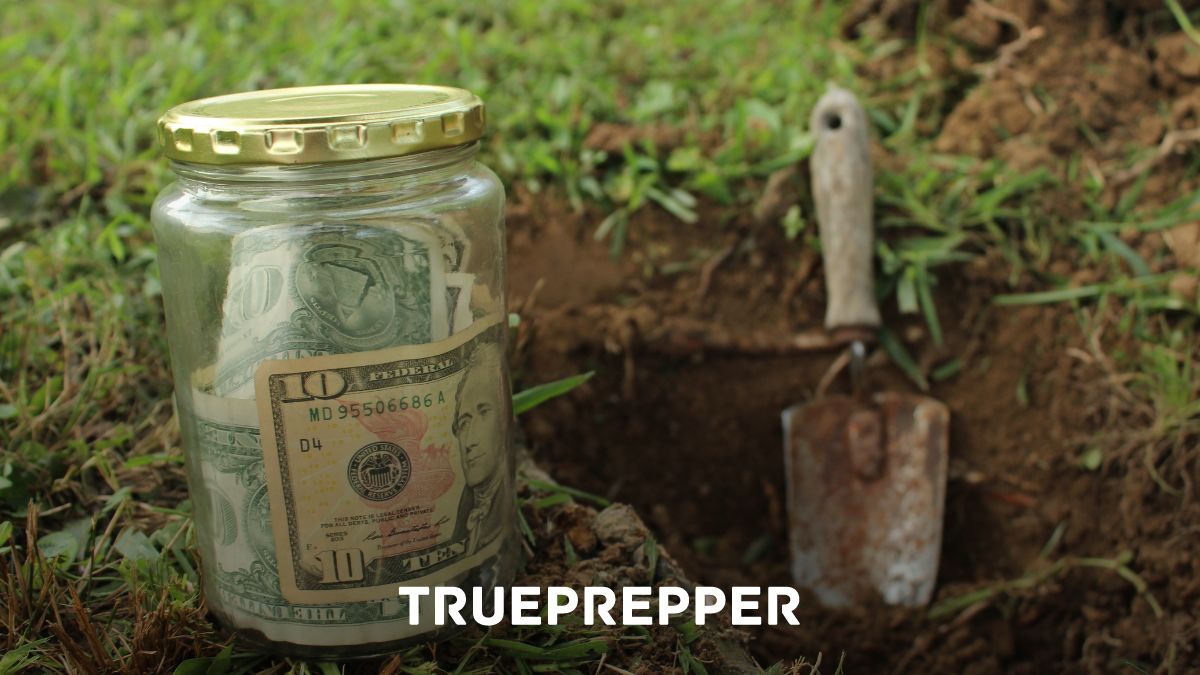
Natural Disasters
Disaster threats identified by our risk analysis:
- Coastal Incidents (4)
- Droughts (5)
- Earthquakes (6)
- Extreme Cold (5)
- Floods (7)
- Heat Waves (6)
- Hurricanes (7)
- Landslides (4)
- Pandemics (4)
- Severe Storms (6)
- Space Weather (2)
- Tornadoes (7)
- Volcanoes (2)
- Wildfires (6)
Accidents
Accident threats we cover include:
- House Fire (9)
- Power Outage (3)
- HAZMAT Incident (3)
- Nuclear Accident (2)
Attacks
Attack threats include:
- Home Invasion (9)
- Cyber Attack (8)
- Bombing / Active Shooter (6)
- Biological Attack (2)
- Electromagnetic Pulse (EMP) (1)
- Nuclear Attack (1)
- Conventional Attack (1)
- Chemical Attack (1)
- Radiation Emitting Device (RDD/RED) (1)
House Fire
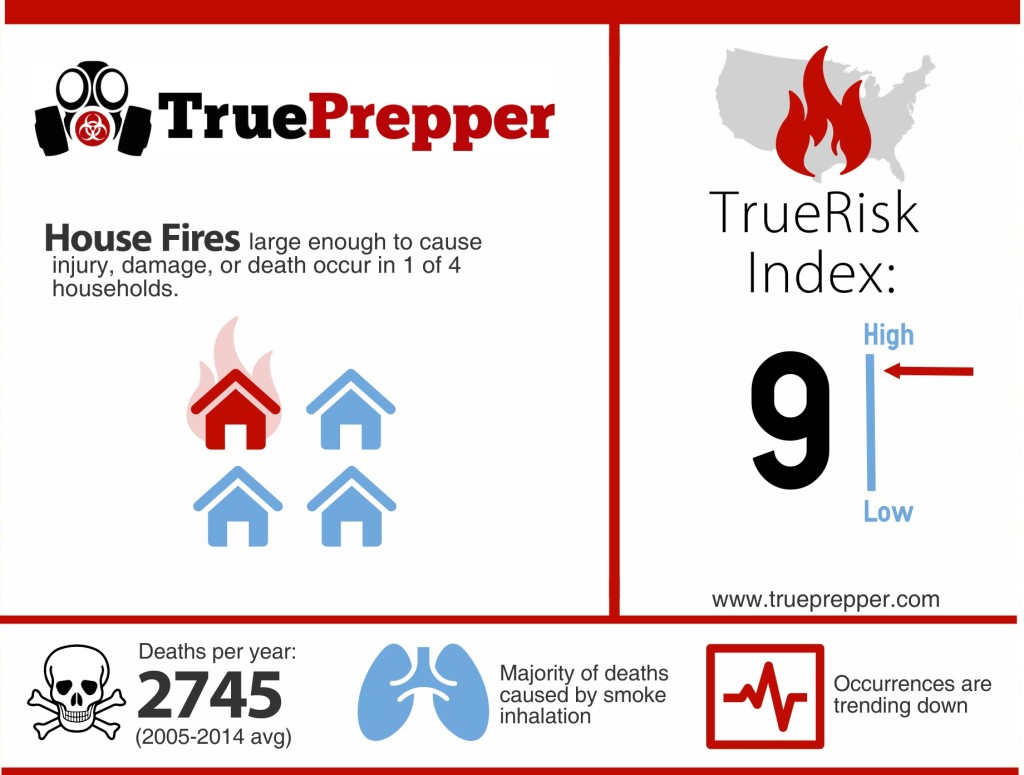
About House Fires
In the US, 2,500 people die and 12,500 are injured in house fires every year. The average number of house fires you can expect to encounter in your lifetime is 5. You are much more likely to encounter a house fire than not to. Although most are small, one in four of those fires are reportable with the potential for serious injury and damage. House fire property damage is ridiculously expensive- estimated at $7.3 billion every year. That’s almost a billion MREs! The main thing to take away from this is that most fires could have been prevented.
- Prevention is Key: If you are a smoker, stay aware of your butts. Make sure they are out before you dispose of them. If you are a chef, or like to pretend like one, make sure you watch your stovetop and oven. Kitchen fires are the most common house fires. Small appliances, space heaters, fireplaces, and mischievous children are also prime suspects for causing fires.
- Stay Alert: I know, fire alarms, carbon monoxide alarms- they always beep their first ‘battery low’ beep in the middle of the night. And if you have two close to each other – good luck figuring out which one is dying it’s slow death. But they save lives. It has been proven. Keep your alarms working and juiced up with backup batteries. If I gave you a 3-minute heads up that someone was coming to kick in your door to burglarize your home, would you appreciate it? I know I would be prepared and loaded to go! The average escape time once an alarm goes off is three minutes. Not enough time to gather everything you own, but enough to get your loved ones and Bug Out Bag out.
- Fire Spreads Quickly: Fire is fast, and most modern houses are just filled with fuel for fires. Fire can spread very quickly so you need to be sure to be quick on your feet and in your reactions. Smoke is three times more likely to kill you in a house fire than burns, so keep low if needed to avoid too much smoke inhalation.
- Extinguish the Threat: If you don’t have a fire extinguisher, you should get one. If you have one, or when you get one put it in a logical place, like under the sink or near the stovetop. Let everyone know where you are keeping it that lives in the house. When you have a guest at your house cooking, be sure to mention where the extinguisher is. It makes for a pretty good joke if you let them know you believe their cooking has a chance to burn your house down without one.
Severity of a House Fire
House Fires are commonplace and have a wide range of incident severity. A house fire can span from a small kitchen fire to losing your home and having injuries or even deaths. A small fire can easily progress into a large fire, which sets a fire’s potential danger a little higher than a typical emergency. The severity of almost any unchecked fire is very high, but we are able to extinguish fires and control them with enough forethought and planning.
Determine Your House Fire Risk
A house fire rocks the scale with a 9 on the TrueRisk index. That is the highest risk we measure, and it can be attributed to the high chance of occurring and the destructive potential of a fire. The ability for fires to often show up when other disasters are occurring increases their danger even more since they often can be the result of a ‘domino effect’ with disasters. A ‘domino effect’ disaster is a disaster that follows other disasters, much like house fires often follow earthquakes. The chaotic nature of other disasters makes you much more likely to encounter fires. While geography and other factors can affect your house fire risk slightly, you’re building type and weather conditions do more to change your risk. Dry weather- whether typical or uncharacteristic, can slightly increase the chance of a house fire. Buildings without firewalls are much more likely to burn quickly, making them more dangerous as well. Not having firefighting equipment actually also increases your risk, since a fire that could be controlled would go into an uncontrolled blaze without any equipment to suppress it.
Prepping for House Fires
With most emergencies, we will stress the importance of plans and practice. Both of those are important for fires as well, but equipment is a priority here. If you have limited funds for preparedness, preparing for a fire should be at the top of your list (quickly followed by security). Installing smoke detectors, carbon monoxide detectors, and fire extinguishers in your house should be one of the first things you accomplish when you move. Check on them every six months to be sure they are operational. Be sure to practice, and have everyone in your home know how to operate a fire extinguisher.
Suggested Kits
The two standard kits of a survival kit and bug out bag should be more than effective in dealing with house fires. It is very important that the survival kit includes at the very least the recommended fire extinguisher, however. The suggested kits:
Suggested House Fire Plans
These template plans are great for emergencies and easy to practice. Be sure to know the difference and which plan you would be executing. Make sure your family is all on the same page about what they should be doing if they hear a fire alarm or encounter smoke and flames. Remember that practice makes perfect and practice all plans you develop with your family on a regular basis. Here are a few plan templates:
- Basic Emergency Plan
- Bug Out Plan
During a House Fire
Prepping for a house fire is very important because you often do not have much notice. When the fire alarm goes off, each and every person in your house should be able to spring into action and know what to do. If you are being alerted by the fire alarm, you should be evacuating your house as safely as possible. Shout out to alert everyone in the house. Check door handles with the back of your hand to avoid burning your palm. Cover your face from smoke and get low to avoid it, if needed. Smoke rises- so upstairs areas and higher up in rooms and hallways will have more smoke. Smoke inhalation is the number one killer of house fires. Sometimes people escape fires just to succumb to their smoke inhalation injuries if they do not receive medical treatment immediately. If first responders have not been contacted by the time you escape, call them immediately with details of your location.
After a House Fire
If you are lucky enough to have no injuries from a fire, you will need to count your blessings quickly because you need to get back to work. First responders will need information, your family will need to be accounted for and comforted, and insurance adjusters will need to be contacted. It can take a long time to rebuild a home, so concentrate on the things that matter first, such as your family and your own well-being. If the house is just damaged you may still need to make arrangements due to the smoke contamination. Disaster cleaning services specialize in this type of work but be careful of cash-only deals or uninsured work- especially if the fire was a ‘domino’ disaster. Many people chase disasters to make a profit, so it is best to be careful if your fire is connected to a disaster in any way.
Home Invasion
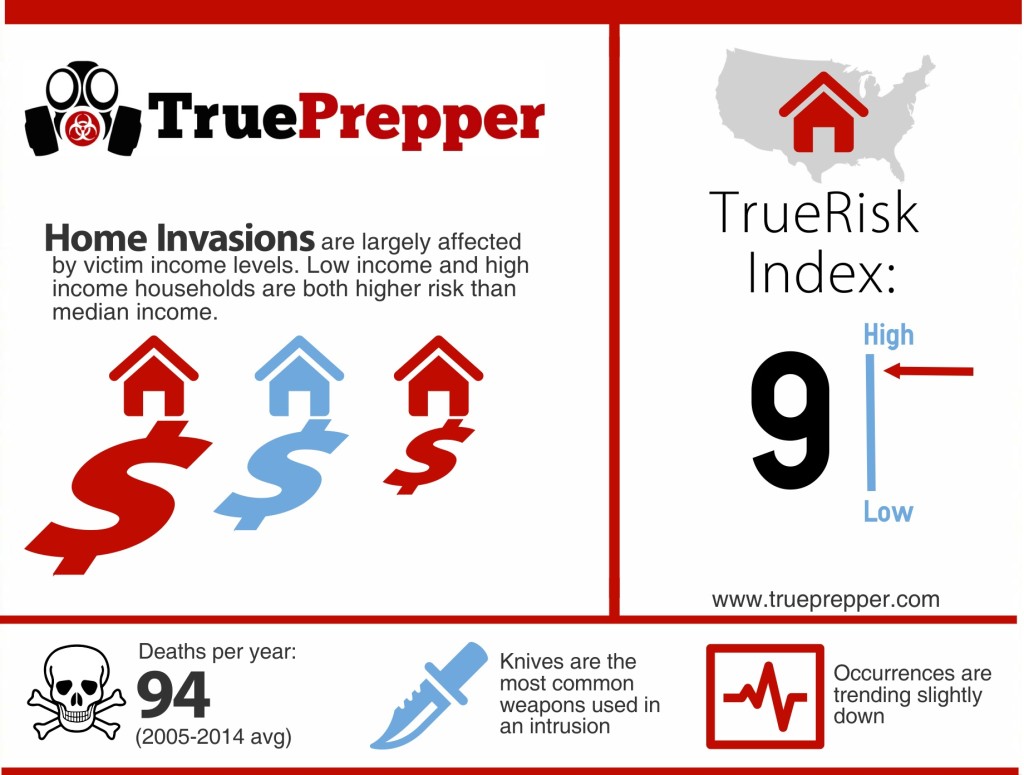
Being a victim of a home invasion can be one of the worst experiences of your life. It will likely leave you rattled, questioning your priorities and the safety of yourself and your family. Many victims often have trust issues, relationship problems, and often seek counseling after a break-in. While it is easy to learn lessons after an incident, this is the one area where prevention does not really take that much time, money, or know-how. Fortifying your home, being able to protect yourself and your loved ones, and keeping intruders at bay should be a part of your prepping plan.
Severity of a Home Invasion
Home Invasions have a wide range of severity. A break-in could occur with the burglar not even taking anything, or someone could break in and commit a murder or rape. Most intrusions fall somewhere in the middle of these two extremes, but the potential for violence at the hands of an intruder puts home invasions in a high-risk category.
Determine Your Home Invasion Risk
We tallied up a TrueRisk score of 9 for home invasions. A 9 on our scale is the highest risk we can measure, so it is very important to be prepping for a break-in. It is even more important to focus on preventing and deterring a break-in. Your specific risk can vary widely on the scale, based on geography, your habits, and your actions. You can determine your own risk by examining the people you associate with, and crime history in your area. If you hang out with people with a poor moral compass, you are more likely to have a break-in. The majority of home invasions are done by people who know the victim and have some sort of inside information as to whether they are home or not. This information is coming more and more often from social media, such as Facebook and Twitter. You can also check your local crime map by getting in touch with your local police department to examine what crimes have recently occurred in your area.
Prepping for Home Invasions
Prepping for home invasions comes down to plans, kits, and practice. Make a plan, organize a kit, and practice both.
Suggested Kits
Having the right resources at the right time is important when it comes to disasters and emergencies. Various kits can prepare you for the worst by letting you have the most resources at the ready. Our suggested kits for dealing with Home Invasions include:
Suggested Plans
Planning for a home invasion is relatively simple. Many templates work just fine for any home invasion scenario. Check out these plans to be sure you are ready for an emergency:
- Basic Emergency Plan
- Bug Out Plan
- You can also plan by preparing your home with basic home defense. Here are a few tips that can help prior to an invasion:
- Plant thorny shrubs around windows.
- Get a dog- they are one of the best deterrents for intruders. Even decoys such as empty dog bowls, dog bones, and “Beware of Dog” signs can help.
- Fortify your entryways with kick plates and door stops.
- Install an alarm system. Popular brands of alarm stickers and placards work well as a deterrent.
- Designate a safe room, have a word you can shout to direct people to it in your house like “safety room” or “hunker down.”
- Consider keeping a weapon in your safe room, preferably a firearm you are thoroughly trained on in a safe.
- Practice your plan for what you have decided to do during a home invasion with your family at least annually.
- Do not broadcast your habits and vacations on social media.
During a Home Invasion
What you do during a home invasion can be the difference between life and death- regardless of how prepared you are. Keep your cool and try to figure out how many intruders there are and what they could be looking for. Be aware that it may not be just a burglar. Avoid confrontation and maintain quiet if possible until you have a good understanding of the situation. Use good situational awareness to regain control of what is happening. Many invaders can be scared by loud directions to leave, the sound of a pump shotgun, or a shout that you are calling the police and/or have a weapon. If the intruder leaves, call 911 if available and report the break-in. If they do not leave, you may not have an intruder who is not at a point where they are listening to reason. They could be under the influence of drugs, extremely emotional, or afflicted with stupidity. You will need to decide on what is best at this critical junction, preferably while calling the police if you are able. Defend yourself and your family with weapons if needed, or escape your home if you believe yourself to be disadvantaged.
After a Home Invasion
Immediately after the home invasion, call the police, if they are available. Even if you managed to keep them from entering your home, you should call the police to notify them. Offer as much assistance as possible to catch the criminal if needed. Criminals often string together crimes to reduce overall exposure, and you may be able to help prevent a home invasion. Reassure and comfort your loved ones as the experience was likely traumatic for them. Write down everything you noticed about the intruders. Take pictures of your home and any damage to it or damage to your possessions. Temporarily repair any damage to entryways. File a police report and insurance claim if needed. Reflect on the lessons learned, and make plans to shore up any weak points to prevent a future break-in. Two weeks after the break-in, follow up with the police and your insurance claim. Complete all plans you have developed to bolster all weak points in your home protection plan. For the long term, make sure you stay aware of local criminal activity. Continue to evaluate your weak points and practice your plans.
Cyberattack
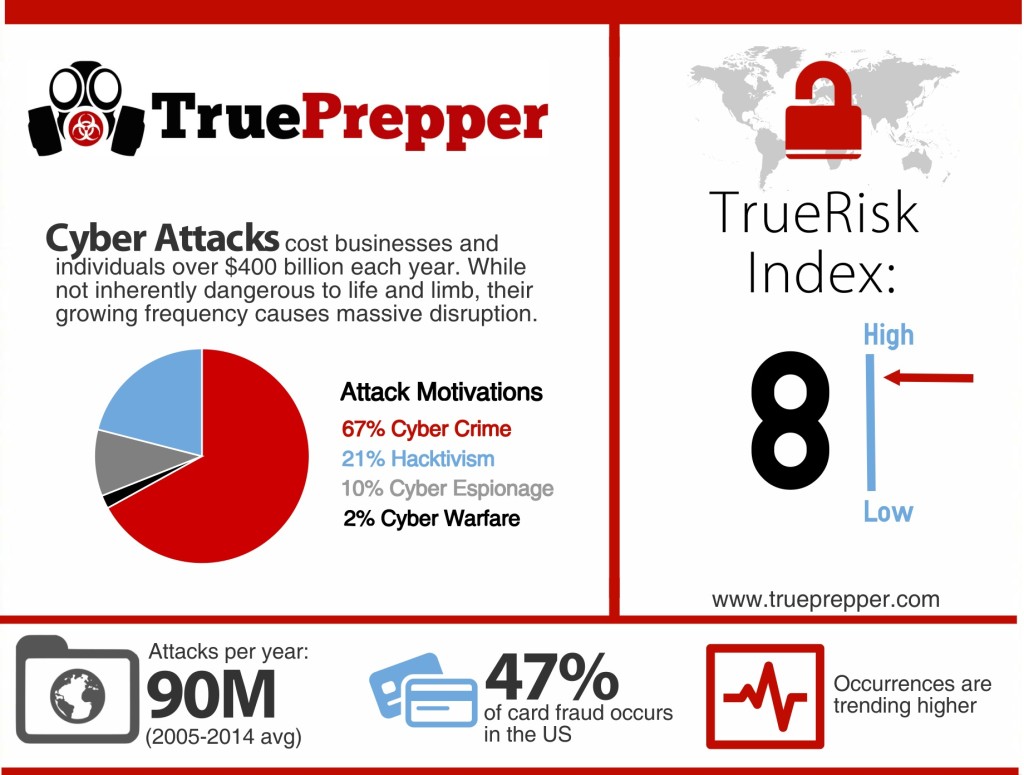
Whether it is simple online credit card fraud or a DDOS attack taking down a government system, cyber-attacks are quietly gaining in frequency and impact. The power of the keyboard is only growing as we store more and more private data in computer databases. Our interconnected society is allowing criminals next door or across the world to steal your identity and steal from unsuspecting victims. Even large businesses are not above this risk, with several high-profile hackings, and many more ‘under the radar events’ occurring more and more frequently.
Severity of a Cyberattack
Cyber Attacks have a very large range of severity. It could be malicious malware on a computer you hardly use, or it could be a series of coordinated attacks carried out on banking sites and servers. While cyber-attacks do not directly threaten life and limb, they are a particularly effective attack against society. For a cyber attack, it doesn’t matter if you are thousands of miles away, protected in your own home, or even speaking a different language- they play by a different set of rules. The bottom line is that our system is vulnerable and the most severe cyber attack could result in financial collapse or even worse.
How Bad Can a Cyberattack Get?
Yes. We all know the Terminator scenario of us inventing our doom with Artificial Intelligence (AI). While that seems far-fetched, we are actively working towards understanding artificial intelligence, and we are relying on interconnected computers more and more every day. Some of us now have smart home devices constantly listening in our homes. Most of us have smartphones that can be controlled remotely. AI is not all that could attempt to shake the foundation of our interconnected society. Election hacking and government leaks have become a common discussion point in many homes. State-sponsored hacking is known to exist and has been used by North Koreans, Russians, and Ukrainians- the list goes on. Our interconnectivity advancements look to be outpacing our cyber defense initiatives and our ethics. Coordinated attacks could easily cripple societies, crash economies, or cause the end of the world as we know it.
Determine Your Cyberattack Risk
Our risk analysis for a Cyber Attack resulted in an 8 on the TrueRisk index. You might be asking yourself or in the middle of typing out an email: “Why?” The answer is all around you in cyberspace. Most of the people accessing the internet are not as secure as they would like to believe. Your IP address (and all the information that comes along with it) can be easily monitored. Companies that store credit card data are increasingly ‘misplacing’ this information. Government databases and emails are being mishandled and leaked. It is so easy to extract information that does not belong to you using the internet that you could even accidentally acquire other people’s information. Your cyber attack risk is in your control and is proportional to how much you expose yourself and your data online. Being familiar with scams, identity theft schemes, and safe credit card usage online can reduce your risk.
Prepping for Cyberattacks
Prepping to prevent cyber attacks is mostly done through learning, planning, and good habits. While some gear can help you out, most of the work is done by what you choose not to do. Oversharing online, downloading unverified files, and frequenting unsecured websites can all set you up for failure. While all of this helps for personal attacks, prepping for large-scale cyber attacks is the same as you would for any type of infrastructure failure.
Suggested Kits
Adding a small Faraday bag to your Every Day Carry can help. Keeping a password-encrypted USB drive with personal data in a safe can help as well. Lastly, a smartphone is a great tool when used properly and vulnerable when it is not. Most of these would be carried on your person and part of your Every Day Carry Kit. If a large-scale cyber attack were to cause a ‘grid-down’ scenario or economic collapse, the standard prepping kits we suggest for those would come in handy.
Suggested Plans
As we mentioned before, the best plans for cyber attack avoidance are to not go to sketchy websites, don’t download viruses/malware, and not over-share personal information online. Being stingy with online card use and keeping strong passwords can also bolster your online security. For a large-scale cyber attack, plan for the cyber attack to be the first domino in a string of infrastructure failures. Power outages, economic collapse, and even military action could result.
During a Cyberattack
Mitigating the effects of a cyber attack is all about timing. If you are lucky enough to receive notification that your data or accounts are compromised, you may be able to mitigate some of the damage. You should immediately call the company where the attack is occurring if you can. Unfortunately, if it is a large-scale attack on infrastructure- there is not much to do except to stay informed of the next steps. Retaliation and the long-term effects of the cyber attack are usually much worse than the attack itself would be to you and your family.
After a Cyberattack
If the attack was a personal cyber attack, such as targeted identity theft, there is much work to be done.
- Call the companies where the fraud/attack happened
- Change your affected account passwords
- Freeze your bank accounts and/or credit card
- Put a fraud alert on your credit report
- Run a credit report
- Report any identity theft to the Federal Trade Commission (FTC)
- File a police report
If the cyber attack is large-scale, you will be dealing with the domino effect of it through other issues and threats. Learn how to recover from power grid failures, economic collapse, and military action all as possible results of cyber attacks.
Hurricane
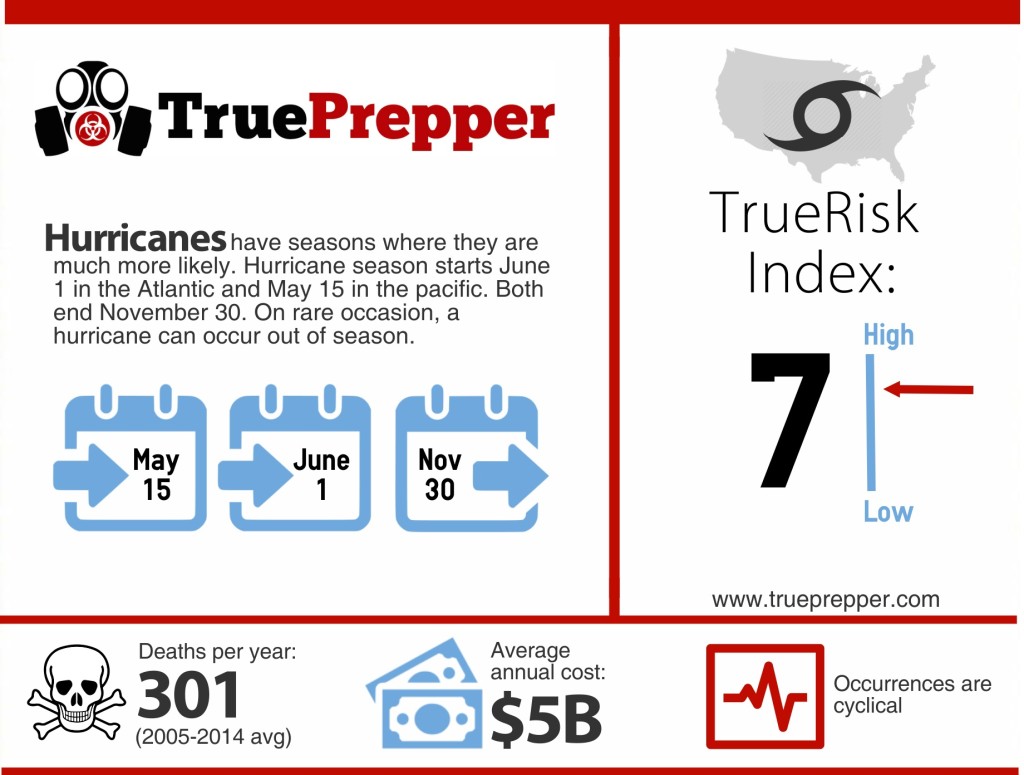
Hurricanes are large, swirling storm systems with powerful winds and heavy rain. A few other names for them include tropical cyclone, typhoon, tropical storm, and tropical depression- depending on the strength and location. Hurricanes are formed over warm water and naturally come cascading towards the coastline through “hurricane season”, which spans June 1 to November 30. The probability of hurricane occurrences noticeably spikes in late August and into September. They are named from a pre-determined list developed by the National Hurricane Center. If you live near a coastline, you need to be thinking about your hurricane risk and preparing accordingly.
Severity of a Hurricane
The severity of a hurricane is measured by the wind speeds. Here are the North American categories:
| Description | Maximum Sustained Wind Speed |
|---|---|
| Tropical Depression | 39 mph |
| Tropical Storm | 74 mph |
| Category 1 Hurricane | 83 mph |
| Category 2 Hurricane | 96 mph |
| Category 3 Hurricane | 113 mph |
| Category 4 Hurricane | 137 mph |
| Category 5 Hurricane | 140+ mph |
Although the higher numbered category hurricanes are well known for the destruction they can cause, the lower wind speed storms can also cause a surprising amount of damage. Some of the most dangerous storms were lower-category hurricanes paired with already water-logged soil. The speed at which the hurricane moves across land also factors in, since prolonged localized flooding can cause problems for months and even years.
Determine Your Hurricane Risk
Hurricane rings in as a 7 on the TrueRisk index. This threat level is dependent on your location, with risk located along the coast in the United States.

Prepping for Hurricanes
There is usually plenty of notice prior to a Hurricane. Many others respond to a Hurricane watch by running to the store and stocking up on “essentials.” Hopefully, you already have food and water storage and plan to ride out a hurricane comfortably. Make sure that your backup power solutions and water runoff are well prepared for since you will possibly encounter flash flooding and power outages.
Suggested Kits
The standard kit duo of in-place survival kit and BoB (Bug Out Bag) should cover most of the bases. The usual advance notice and tracking of hurricanes should make it easy for any prepper to be adequately prepared for the worst.
Suggested Plans
If you live on the coastline, you may want to consider evacuating or bugging out- especially if local emergency management is urging you to. Otherwise, settling in and riding out the storm is the best plan. You may need to mitigate water damage as storm surges and flash floods occur. You may also need to start a generator or light candles when the power goes out.
- Bug Out Plan
- Bug In Plan
During a Hurricane
When a hurricane arrives, there is very little to do except to ride out the storm and stay informed. If anything disastrous occurs, like a tree falling on your house, you may need to mitigate the damage right away. The supplies you already have on hand and your survival kit should be a start for most damage. Keep your family safe, and towards the center of a house. If the hurricane is strong enough, tornadoes and straight-line winds can do a large amount of damage. The eye of the hurricane is not a good time to go outdoors to evaluate damage- the backside of the eye is often the most powerful part of a hurricane and you do not want to be outdoors when it arrives.
After a Hurricane
After the storm completely passes, do a damage assessment of your property and assets. Chronicle all damage prior to fixing it with photographs and notes, especially for insurance companies. If you cannot get your home habitable quickly, you may need to make arrangements to stay elsewhere until disaster recovery can assist you. There are many ‘carpetbaggers’ that come around offering to remove trees at very inflated prices- report any of these incidents to the authorities if possible. The practice of price gouging victims of disasters is not just sleazy; it is illegal in some states.
Tornado
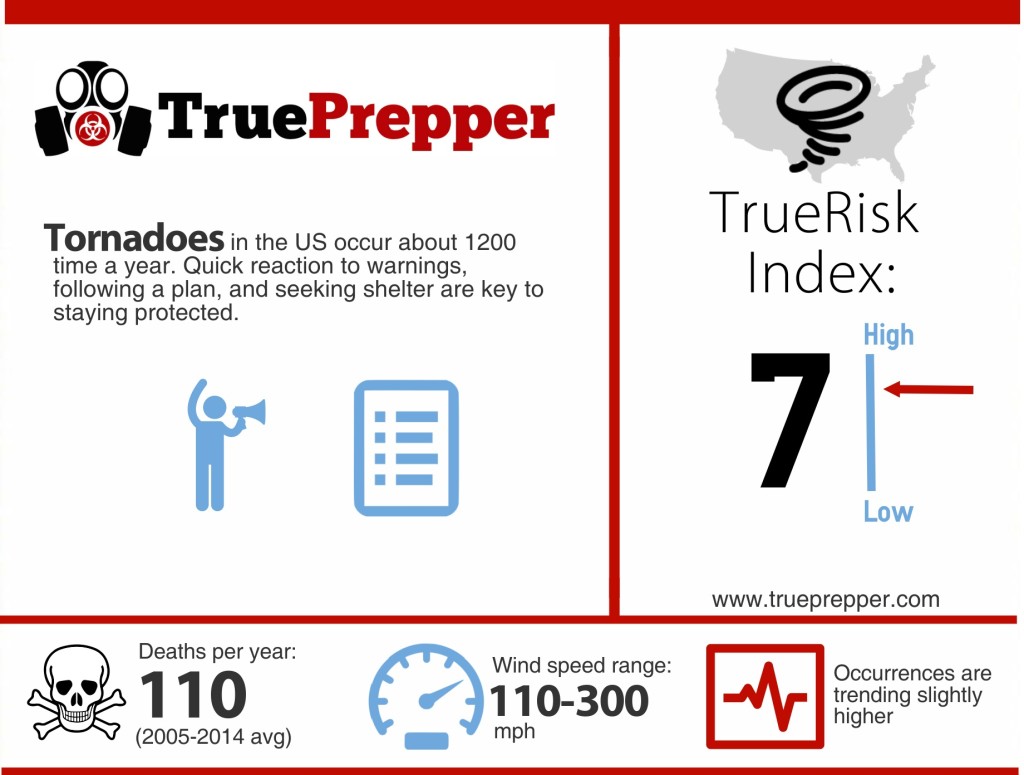
Severity of a Tornado
Determine Your Tornado Risk
Prepping for Tornadoes
Suggested Kits
Suggested Plans
During a Tornado
After a Tornado
Flood

Floods are usually slow and predictable, but for some reason, they are one of the most deadly disasters. Victims tend to be young, elderly, or operating a vehicle- but floods still pose a dire threat to anyone near one. The risen water level itself is not the only danger since the aftermath of a flood leaves damaged structures, mold, sewage, and displaced disease vectors such as rats. Besides flash floods and natural disaster-related flooding, there is the possibility of long-term water level changes due to global warming- whether cyclical or man-made. Hurricanes, severe storms, and heavy precipitation can all cause flash flooding, especially in basin areas.
Severity of a Flood
Flooding is a severe natural disaster that poses more danger as the water levels rise. This is mainly due to the lack of preparedness of those outside of 100-year floodplain maps. A flood map with levels denoted at the ‘100 year’ mark simply means that the current odds of a flood to that level in a given year is 1/100. There is no such thing as ‘overdue for a flood’, or predicting these floods over a long period since they are odds-based and not by timeline.
How Bad Can Flooding Get?
The one significant event that could occur relating to flooding is if all of the ice caps melt rapidly. If it is slow and gradual, society may be able to adapt over long periods to the changing coastline. National Geographic has published maps of what the world would look like without ice caps, and it is surprisingly not too different looking. Florida would be gone, and most coastal cities would be underwater, but general land masses stay the same. In this event, flooding would be the least of our problems since the ice caps no longer present would have an impact on the weather. Droughts, heat waves, and other disasters and global weather pattern shifts would likely decimate crops and water supplies around the world. The combination of all of these challenges would surely stress our society and create a very different experience than we live today.
Determine Your Flood Risk
The TrueRisk index for Floods is a 7. This is extremely dependent on your geographic location, proximity to water sources, and the drainage characteristics of your land. FEMA has published maps in ArcGIS of 100-year flood plains that you can research on your home, work, and bug out location. If you live in one of these areas, you have likely been contacted by an insurance company since they monitor these maps closely. Regular homeowners insurance rarely covers flood damage, except where required by law. Taking a look at these maps to determine your risk is a great idea and a starting point when prepping for floods.
Prepping for Floods
A flood is hard to combat and is best served by preparing with a bug out plan. A bug out bag and alternate bug out location are both required. Often, advance notice will be given of federal and state-mandated evacuations. It is important to heed these warnings, or you may end up being that family stuck on their roof with the TV chopper filming you.
Suggested Kits
Some tools make it possible to combat flooding. Sandbags to specially built inflatable walls can be used to keep your home out of the water, but both have their limitations. If the water rises too high, you are in the same predicament as everyone else at lower water levels. Bugging out and evacuating is the surefire choice unless you are already surrounded by water. It is possible to become stranded in a vehicle during a flood, so a small car kit can go a long way too.
Suggested Plans
Planning for a flood is simple. Determine your risk level with a flood plain map, and then determine if you should include preparing for floods in your bug out plan.
- Bug Out Plan
During a Flood
Floods usually have plenty of notice, and sophisticated warning systems are in place using emergency radios, TV, and cell phones. Staying informed during a flood warning is one of the more important tasks you can do, in case evacuation is needed. You can also actively monitor your property and mitigate flood issues, like clogged drainage or diverting water flow as needed. Flooding can happen quicker than you may expect, so be flexible and aware of the situation.
After a Flood
Flood waters can stagnate and stay at high levels well after the water initially rises. River basins are well known for this after regional storms or hurricanes. As the water subsides, it will leave behind damaged property, sewage, and even possibly remains. There have been several instances where extreme flooding has exhumed graves in cemeteries. Sanitation can be an issue after a flood, and post-flood areas are a festering ground for disease and sickness. When cleaning out anything flood-damaged, it is a good idea to wear gloves and a respirator to avoid mold and disease exposure. Be sure to thoroughly check your home after a flood for any water damage or mold growth. If applicable, make sure you contact your insurance company as soon as possible to start the claim process. Regional disasters may make these claims take longer than usual.
Earthquake
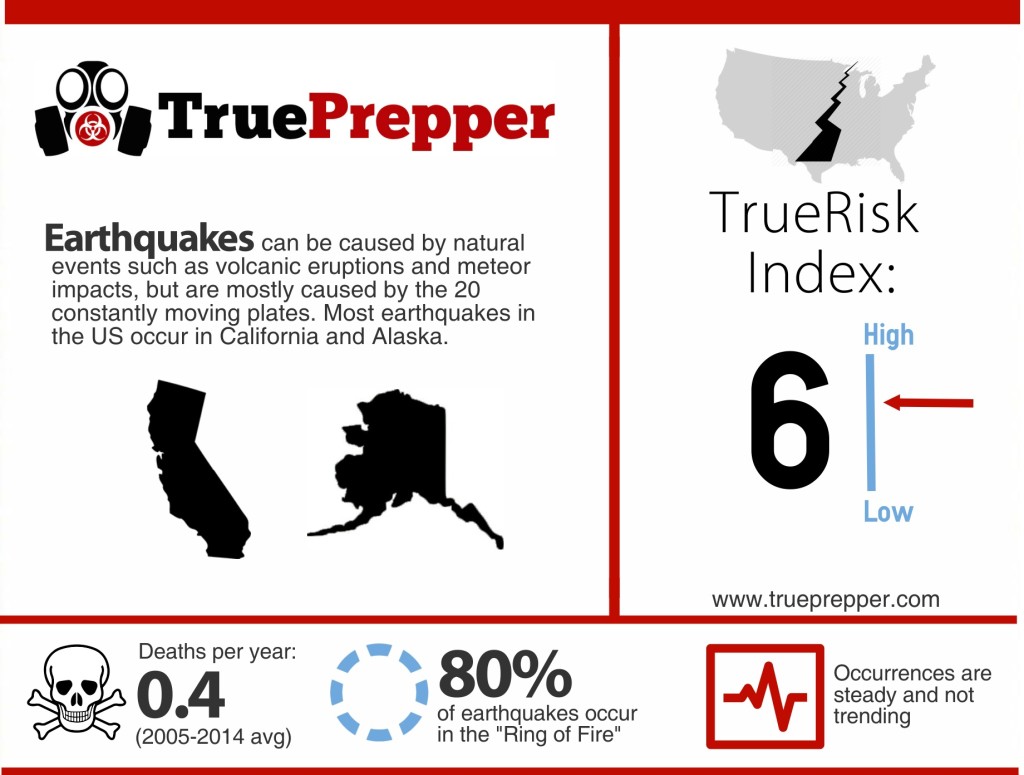
Prepping for an earthquake is pretty straightforward. An earthquake is the earth shaking from seismic activity, usually caused by the constantly moving tectonic plates beneath the earth’s crust. They can also be caused by volcanoes, landslides, or even nuclear detonations. Earthquakes themselves can, in turn, cause volcanic eruptions, landslides, and tsunamis. There are areas of the world where fault activity is more active which can make those areas more prone to earthquakes. Many of these faults fall within the “ring of fire” which is a ring of fault lines that surrounds the Pacific Ocean. About 500,000 earthquakes happen every year but the majority of those are minor and are usually not felt.
The moment magnitude scale is used to measure earthquake magnitude and is a pretty good approximation of an earthquake’s destructive potential. While several other factors affect how much destruction an earthquake could cause, it is easy to compare the energy released as it is measured by the moment scale. It replaced the Richter scale in the ’70s and has been used to describe every large earthquake by the USGS since 2002. These scales are logarithmic (like the TrueRisk index) which means the larger numbers on the scale equal a much larger reading of energy released. An earthquake that registers a 7.0 has released 1000 times more energy than a 5.0 earthquake.
Severity of an Earthquake
As you have probably seen or heard, earthquakes can be pretty severe. The looming threat of a megathrust earthquake hangs over regions near tectonic plate boundaries. These plate-driven earthquakes can exceed a moment magnitude of 9.0. These earthquakes are almost guaranteed to cause a domino effect, or chain reaction. The last earthquake over 9.0 was a megathrust earthquake off the coast of Tohoku, Japan. This earthquake caused a tsunami, flooding, fires, and the Fukushima Daiichi nuclear power plant accident with an estimated economic impact of $235 billion.
How Bad Can an Earthquake Get?
An earthquake, series of earthquakes, or megathrust earthquake could become a chain of disasters leading to significant problems for life on Earth. Shifting plates on our planet has more than enough potential to cause unforeseen devastation to our population.
Determine Your Earthquake Risk
Earthquakes ring up as a 6 on our TrueRisk index. This risk is very geographically dependent since it is higher for those who live near fault lines or areas with frequent seismic activity. While many structures in these areas are built with earthquake codes and higher standards in mind, the increased exposure and potential for megathrust quakes still show vulnerabilities.
The USGS website can send alerts to notify you of earthquake activity and map out earthquakes:
Prepping for Earthquakes
Depending on the magnitude, the kits and plans that you will need can change. While a megathrust earthquake will require a full survival kit and possibly a bug out bag and plan, more common earthquakes simply need an earthquake kit and plan.
Suggested Kits
While most of the kits listed below are for the worst-case scenario, they can help during more common, lower-magnitude earthquakes as well. The earthquake kit is a specialized kit that everyone who lives near a fault line should invest in.
- Survival Kit
- Bug Out Bag
- Get Home Bag
- Specialized Kits – Earthquake Kit
Suggested Plans
Planning is very important for earthquakes and should be done well in advance. Earthquake-proofing your home should be a part of your typical emergency plan, as well as what you plan to do in the event of an actual earthquake.
- Emergency Plan
- Bug In Plan
- Bug Out Plan
During an Earthquake
Whether you receive advanced notice or are just noticing the tremors, you will want to see shelter immediately. If you do not have a designated shelter in the center of your home or building, hunkering down under doorways and sturdy furniture is the best idea. Steer clear of heavy wall hangings, bookshelves, or anything else that could fall, tip, or collapse. Earthquakes often are accompanied by aftershocks, so don’t assume the earthquake is over after the first tremor.
After an Earthquake
Once the aftershocks have subsided you will want to make sure that everyone is accounted for and not injured. If there are injuries or casualties, administer first aid if you are trained and have authorities contacted if you are able. Be wary of domino effect disasters after an earthquake that could include, but are not limited to: volcano eruptions, tsunamis, house fires, HAZMAT incidents, and landslides. Most of these depend on your location geographically or how your home is constructed, so researching these threats is important before you experience an earthquake.
If your building or house structure is damaged in any way, you should make arrangements to stay elsewhere. If you are in an urban area, search and rescue personnel will likely relocate you anyway, so making arrangements sooner rather than later is best. Take time after the earthquake to reflect on the disaster and shore up any elements of your plan or kit that you found lacking.
Severe Storm
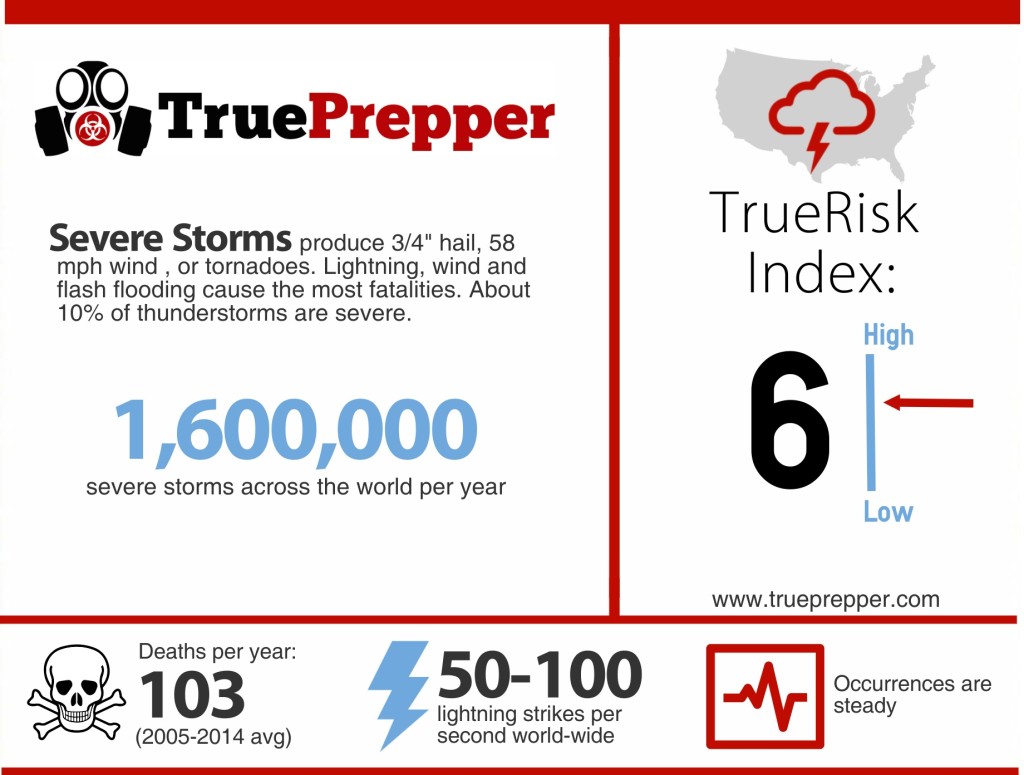
Severity of a Severe Storm
Determine Your Severe Storm Risk
Prepping for Severe Storms
Suggested Kits
Suggested Plans
During a Severe Storm
After a Severe Storm
Wildfire
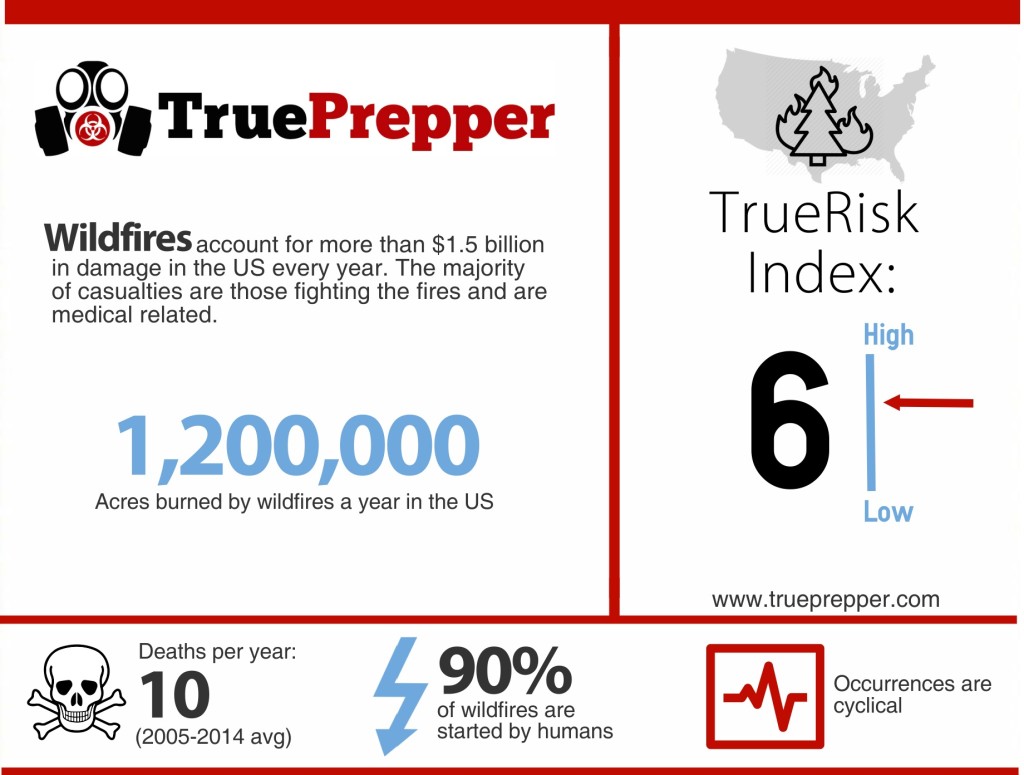
Severity of a Wildfire
Determine Your Wildfire Risk
Prepping for Wildfires
Suggested Kits
Suggested Plans
During a Wildfire
After a Wildfire
Heat Wave
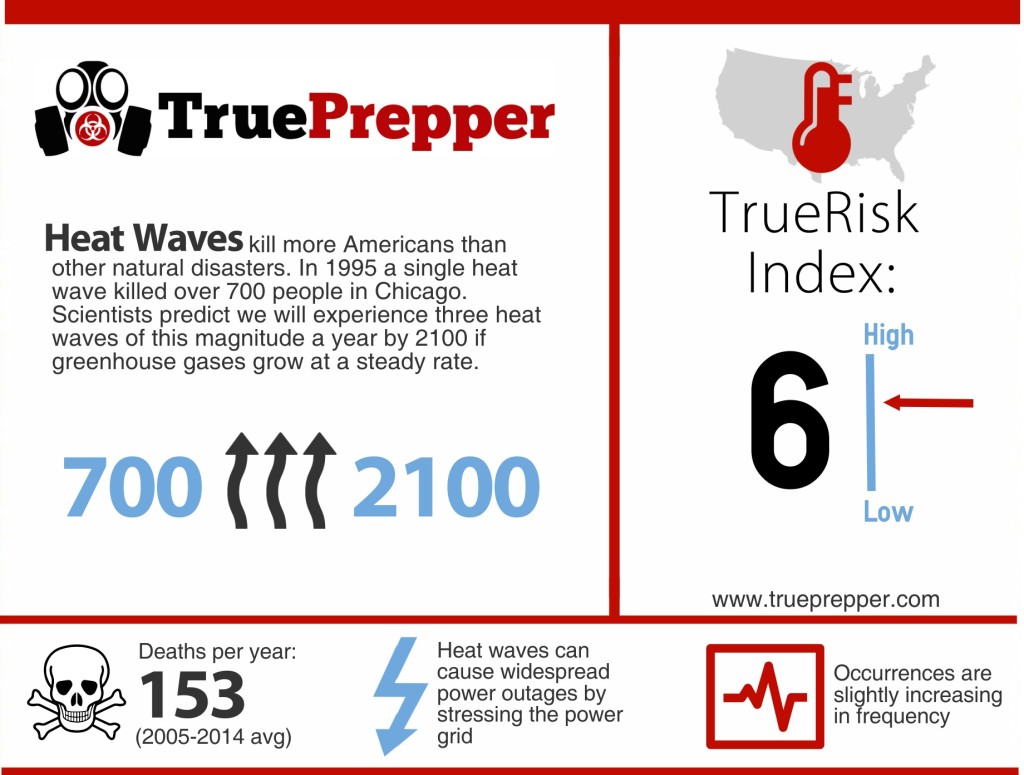
Heat waves are pretty simple and straightforward, but can be very deadly. Any extreme temperature for a prolonged period poses a risk, especially if you do not have shelter and climate control amenities. While heat waves are the polar opposite of extreme cold weather, they both share the idea that they can increase the risk of other disasters. In addition to making disasters such as droughts and wildfires more common, heat waves themselves are more dangerous in the aftermath of other disasters too. A heat wave after a hurricane or other regional disaster displaces thousands of families would be much harder to contend with.
Severity of a Heat Wave
A heat wave may not pose a large threat early on, but when combined with other disasters or if they last an extremely long time, they can have severe consequences. The severity of a heat wave is directly tied to how long it has been going on and how extreme the temperature variance is. Other factors, such as wind chill and humidity can also affect how it hampers outdoor activity.
How Bad Can a Heat Wave Get?
While unlikely, a prolonged heat wave or weather pattern shift could cause significant global issues. Heat waves already cause damage and devastation to ecosystems, so an extreme and prolonged heat wave could easily cause permanent damage. Most likely it would manifest as perfect drought conditions, causing strain on the food supplies of the world. Civil unrest follows- and you get the picture.
Determine Your Heat Wave Risk
The TrueRisk index lists heat waves as a 6 risk factor. This risk is geographically dependent, but can still occur in most places in the world. Deserts and arid climates are very susceptible to heat waves, but they tend to affect those areas less since the regions are accustomed to them.
Prepping for Heat Waves
Prepping for a heat wave can be pretty simple. If you prepare for the worst and hope for the best, you will be covered for a heat wave. Common sense is the best tool you can bring since most heat wave casualties are from overexertion. Don’t overdo it outdoors and know the limits of your body.
Suggested Kits
A standard survival kit will help alleviate concerns with equipment, food, and water storage that could arise from heat waves and associated disasters. A first aid kit is important when a heat wave affects you or a family member from over-exertion or heat stroke. Having plenty of fluids around, and even items that combat dehydration will be useful. Pedialyte and antidiarrhetics are both useful for this.
Suggested Plans
Having an emergency plan in place prior to a heat wave is important. Communicating the plan is equally important. Having your family know who or what to call in the event of an emergency can save a life. If you become overexerted outdoors during a heat wave, you will need immediate medical assistance to stand a chance. Whether your plan involves contacting help or using family members trained in medical first aid, you need to have it planned ahead of time.
During a Heat Wave
During a heat wave, you want to stay indoors or in the shade as much as possible. If you do need to go outdoors, you need to block direct sunlight with clothing or shelter and drink fluids often. Knowing the signs and symptoms of a heat stroke can also help you avoid lasting damage. If the heat wave is prolonged and starts affecting infrastructure through drought and supply chain problems, you may need to tap into your food storage. It is difficult to predict the end of a heat wave, so ration your storage appropriately to plan for the worst-case scenario.
After a Heat Wave
If you tap into your food storage supplies, you should replenish them as quickly as possible. Heat waves usually are seasonal, and most likely you are still ‘in season’ for another heat wave to occur. If you had any injuries or sickness occur, consider tweaking your plans to adjust to be better prepared next time.
Bombing / Active Shooter
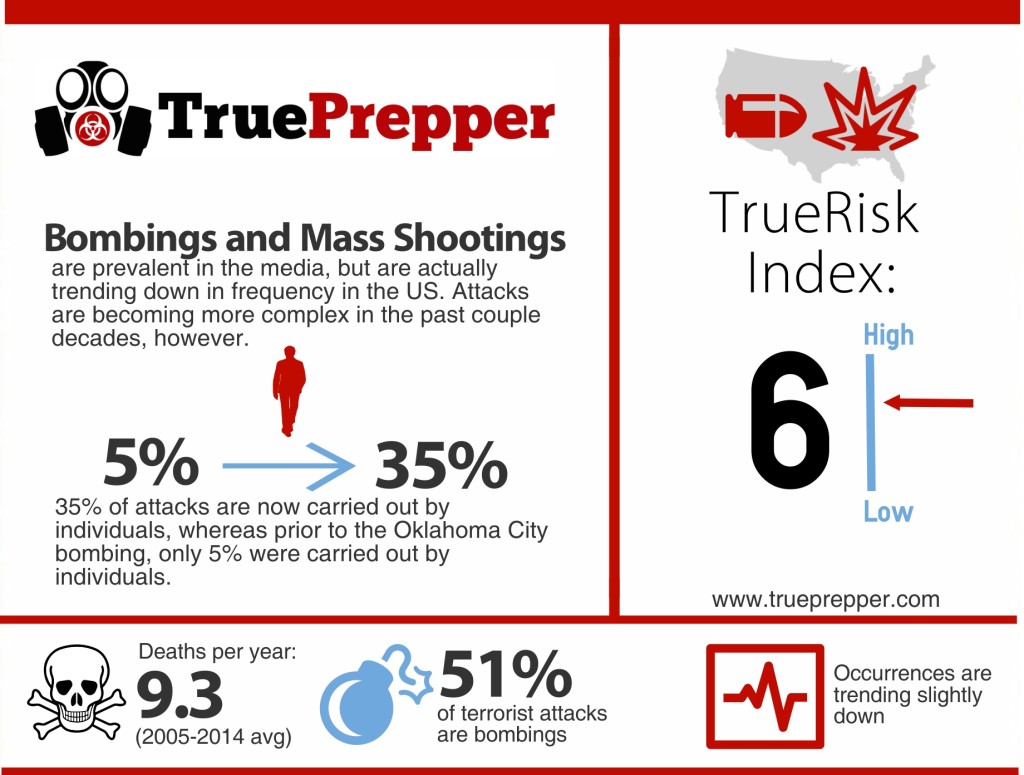
Bombings and mass shootings have quickly become a terrorist favorite, and it is easy to see why. The seemingly unpredictable acts are on the front page of every news section and covered extensively by the media. Graphic depictions of violence are prevalent in our internet-connected age, and these atrocities are burned into our collective memories. Live video feeds and social media have only amplified the message the shooters and bombers are trying to send. These events strike fear into the public’s heart and easily disrupt society on local and global levels. Oklahoma City, Sandy Hook, and Columbine- all of these attacks have become permanent fixtures of our culture and are not forgotten in our memories. Each attack leveled on innocents reminds us of the ones that came before and the persistent evil and danger that exist in this world. This is one of the basic reasons a prepper is driven to prepare, and being able to combat a bombing or mass shooting is a noble calling for a prepper to answer.
Severity of a Bombing or Mass Shooting
Bombings and mass shootings are usually limited to moderate severity. Despite the many deaths that can occur, the majority of the damage is the public psychological impact, due to the widespread reach media provides. The bombings or shootings themselves are almost always isolated incidents and directly affect a limited number of people.
Determine Your Bombing and Mass Shooting Risk
A bombing or mass shooting risk registers as a 6 on the TrueRisk index. While the world has been adapting to this evolving threat, the risk is still apparent with each and every attack we witness. It seems as if no population group is off limits, as various religions, ages, and countries have all been victims throughout the last decade. Bombings and mass shootings are very unpredictable, but you are most likely to encounter them when out and about. The deadliness of these attacks and their effect on society raises this TrueRisk score to a relatively high level.
Prepping for Bombings and Mass Shootings
Your plans and kits will need to be mobile-oriented. Most of these events occur in public places when you would be out and on the go. Being prepared while you are mobile is much harder, especially if you travel through airports or other security areas.
Suggested Kits
The only way to truly be ready anywhere is to have the gear you need everywhere. Carrying resources on your person can be difficult to get used to, so weight and multi-functionality is important. Check out the everyday carry kit for more information:
Suggested Plans
Basic situational awareness is the best plan for avoiding or preventing bombings and mass shootings. Understanding your situations and the threats you could be presented with. Scanning rooms on entry for exit points, blind spots, things that don’t belong, and suspicious people are all good situational awareness practices. Stay sharp and keep your head on a swivel.
During a Bombing or Mass Shooting
When a bomb goes off, there is not much to do except immediately seek cover and then escape the area. You should assist others if you are able. During a mass shooting, you will want to escape first and seek cover second. If you are in an open area do not run in straight lines- make yourself a difficult target by ducking and weaving. If you have an opportunity to rush a shooter during a reload or when they have their back turned, do not hesitate. Shooters often do not expect resistance in these scenarios and can be caught off guard. If you carry a concealed weapon, use your training. Shoot from behind cover and be sure to know what is behind your target- you do not want to add to the casualty list.
After a Bombing or Mass Shooting
When the dust settles, do not let your guard down. It is becoming more commonplace for terrorists to have secondary devices and events targeting responders to the first incident. Seek medical attention if needed, and if the event was a bombing be aware that you very easily could be suffering from a concussion. The blast can cause concussions and long-term traumatic brain injury (TBI) and chronic traumatic encephalopathy (CTE) even if you are not injured otherwise. Stay informed and know what resources are available to you, and assist by providing information to help apprehend suspects if they are not yet caught.
Extreme Cold

Temperature is an expedient killer. Our bodies are not made to tolerate extreme temperatures, which is one reason why shelter is a core requirement for survival. Modern conveniences have made survival in places with cold weather patterns possible, and even comfortable. Heating and shelter can be easily compromised during disasters and SHTF, which makes for a delicate house of cards of protection in these areas. Backup heating sources and shelter solutions are almost a necessity for survival redundancy. Weather patterns that include extreme cold risk are common:
- Blizzards
- Snow Storms
- Freezing Rain
- Sleet
- Hail (although hail is not indicative of cold weather at ground level, we have included it in this risk assessment)
- Arctic Blast
A few uncommon events could also occur. Many of these would be caused by a chain reaction from another disaster or SHTF event.
- Nuclear Winter
- Ice Age Event
Severity of Extreme Cold
The severity of weather based on temperature is affected by the actual temperature, weather conditions such as wind and precipitation, and the longevity of the event. Prolonged blizzards with below-freezing temperatures can be deadly, even with modern conveniences. They can prevent travel and first responders from reaching those in need. Power outages instantly become a matter of life and death. Any combination of emergency or disaster is immediately severe and life-threatening. On the other hand, places that are used to cold weather easily weather small snow storms. The severity of these situations is minimal.
How Bad Can Extreme Cold Get?
A weather pattern with extremely cold weather and/or precipitation that lasts an unusually long time could cause severe issues on Earth. This could be a modern-day ice age, or the after-effect of another risk such as a nuclear winter caused by coordinated nuclear attacks. While the probability of extreme cold causing TEOTWAWKI is very low, it increases slightly with human weather tampering.
Determine Your Extreme Cold Risk
Extreme cold rings in as a 5 on the TrueRisk index. This threat level is dependent on your location, for the most part. Geographically, higher altitude areas and places further from the equator are more susceptible to extremely cold weather. This also usually means that these places are more prepared for it, which makes cold weather particularly dangerous for tropical areas if they were to experience it. The balance of high impact, low probability in hotter areas, and low impact, high probability in colder areas lends the idea that everyone should be prepared for cold weather events on a basic level. To determine your risk level, check out your geographic weather patterns and see if you have any redundant heating systems available.
Prepping for Extreme Cold
There is usually plenty of notice prior to an event with extreme cold. Many others respond to this notice by running to the store and stocking up on “essentials.” Hopefully, you already have food and water storage and plan to ride out any event comfortably.
Suggested Kits
Getting home and surviving at home or when stranded should be the goals of your kits. Set yourself up for survival by stocking plenty of food and water. Keeping additional clothing in your car kit and get home bag is a good consideration as well.
Suggested Plans
Attempting movement is not advised during extremely cold weather patterns, so bugging in is usually the best option. If you are trapped away from your home, you may need to find refuge somewhere closer.
During Extremely Cold Weather
There is usually very little to do during a cold weather event. Hunker down and stay warm. Be prepared for a power outage and/or problems with heating systems. Deal with problems as they arise and pass the time with rest and recreation. Keep spirits up as you ride out the storm. You may need to venture outside to clear precipitation off the roof if it looks as if it could cause problems. Too much snow buildup could cause a roof collapse, especially on roofs with a low pitch. In Buffalo, New York, and Montreal, Quebec they even have building codes with a minimum pitch so heavy snowfall does not cause weight issues. Trees can also be weighed down by freezing rain and precipitation, so know falling trees and limbs could be an issue if trees are close to your house.
After Extremely Cold Weather
Clearing snow drifts may be necessary after blizzards and snow storms. If you have any damage to your home, patch holes with a tarp and call an insurance adjuster if needed. If your heating system struggled to keep up, you may want to have it looked at. Be sure to replenish any supplies you may have used to get through the weather and conduct an inventory. Evaluate your emergency plans and change anything that could help for future storms.
Drought
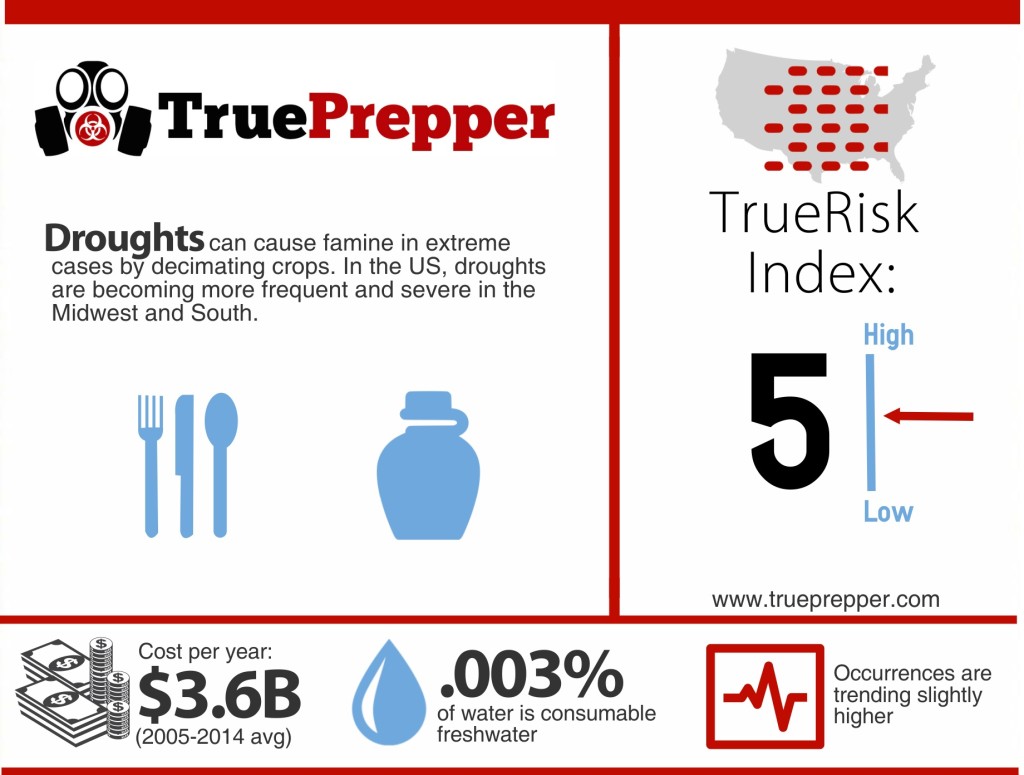
A drought is a long period where there is no rainfall or a low amount of rainfall. This often creates a water shortage for people, crops, and/or livestock. A drought can also be caused if a river or well dries up. They can last years and can decimate agriculture and ecosystems. The recent California drought lasted a long time and many scientists and farmers attempted to find ways to curb the effects of the drought. Methods to prevent freshwater evaporation and to tap into water resources far away were employed to help the situation. Droughts in less developed countries can be extremely dangerous for the people, crops, and economies. Unfortunately, many less developed countries also happen to be in areas of the world where drought is common.
A drought can be an important piece in a disaster ‘domino effect’. A drought can cause other disasters and make them much more likely, like wildfires. Even non-natural disasters such as an economic collapse could occur due to drought and other related hardships. A drought can also be caused by other disasters, notably extreme heat. A drought usually affects your chances of survival more when it is paired with other disasters, emergencies, or SHTF situations.
Severity of a Drought
The severity of a drought usually depends on its longevity and the dependence on the water. A long drought in farm country will have a much more severe implication than a short drought in the city. As mentioned before, when combined with other disasters a drought can become much more severe.
How Bad Can a Drought Get?
An indefinite widespread drought could end the world as we know it. While this is not the most likely scenario when we look at drought risk, the possibility is still there. To have this happen, natural weather patterns would need to change rapidly or man-made manipulation would need to occur.
Determine Your Drought Risk
We determined a TrueRisk index of 5 for droughts. This risk has been steadily rising as weather patterns slowly grow more polarized and drastic. Your specific drought risk may widely vary when compared to the TrueRisk index for droughts. This is because you can mitigate the effects of a drought on you and your family easily with food and water storage.
Prepping for Droughts
Droughts are the type of disaster that a prepper should be completely prepared for. With food and water storage being a cornerstone of prepping, a drought should not pose a short-term threat to anyone prepared for one.
Suggested Kits
A survival kit stocked with plenty of food and water should be more than sufficient to deal with most droughts. If the drought is an indefinite world-altering drought, you may need a few more supplies and a plan for long-term sustainability.
Suggested Plans
No specific plan is needed besides a rationing plan. Water and food rationing can help your storage supplies last much longer.
During a Drought
When you first learn of a drought, you should conduct an inventory of your water and food storage as soon as you can. If you find any low supplies, you may still have time to purchase some before the drought gets too bad. Cutting back on water consumption should be your next priority. Next, consider a rationing plan to extend your supply. Rationing food and water may be difficult, but it can greatly extend your long-term survivability. Lastly, consider reusing grey water when possible. While most droughts won’t cause you to need to do most of these, one big regional drought could cause you problems.
After a Drought
Replenish any supplies you may have used up during the drought. If you have any crops or gardens affected, you may want to attempt to salvage what you can. Try to come up with ideas on how you could have been better prepared for a drought, even if you were not immediately affected. Go through with any changes you come up with in the next two weeks so you do not push them to the side and forget about them.
Pandemic
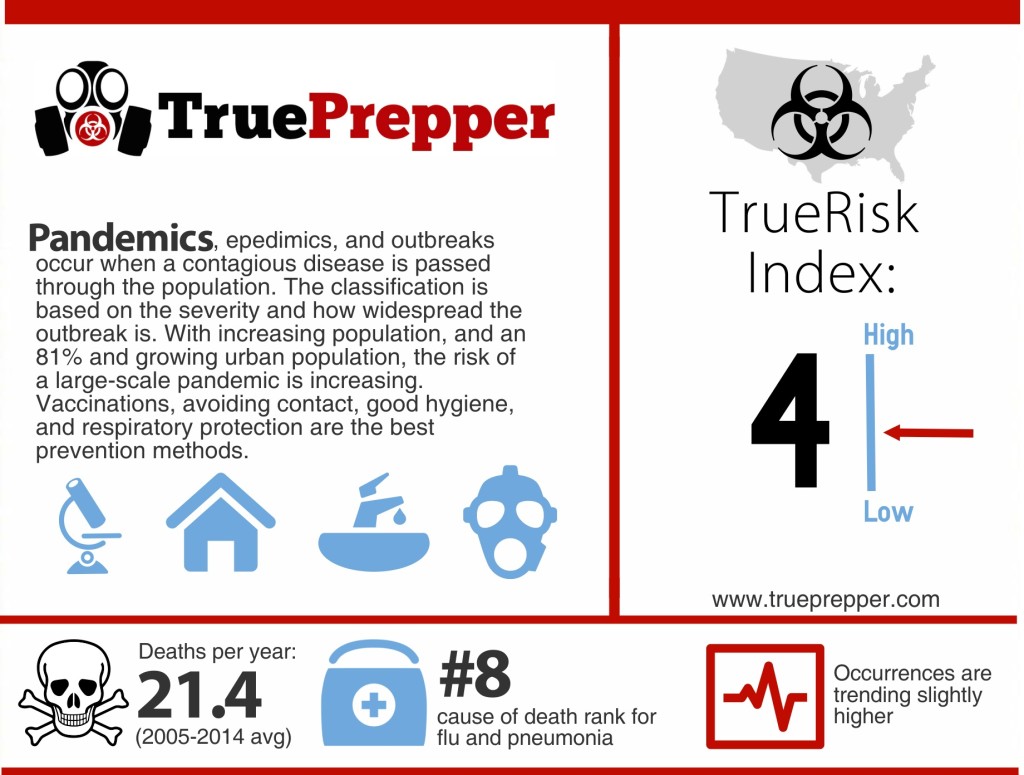
Severity of a Pandemic
How Bad Can a Pandemic Get?
Determine Your Pandemic Risk
Prepping for Pandemics
Suggested Kits
Suggested Plans
During a Pandemic
After a Pandemic
Landslide
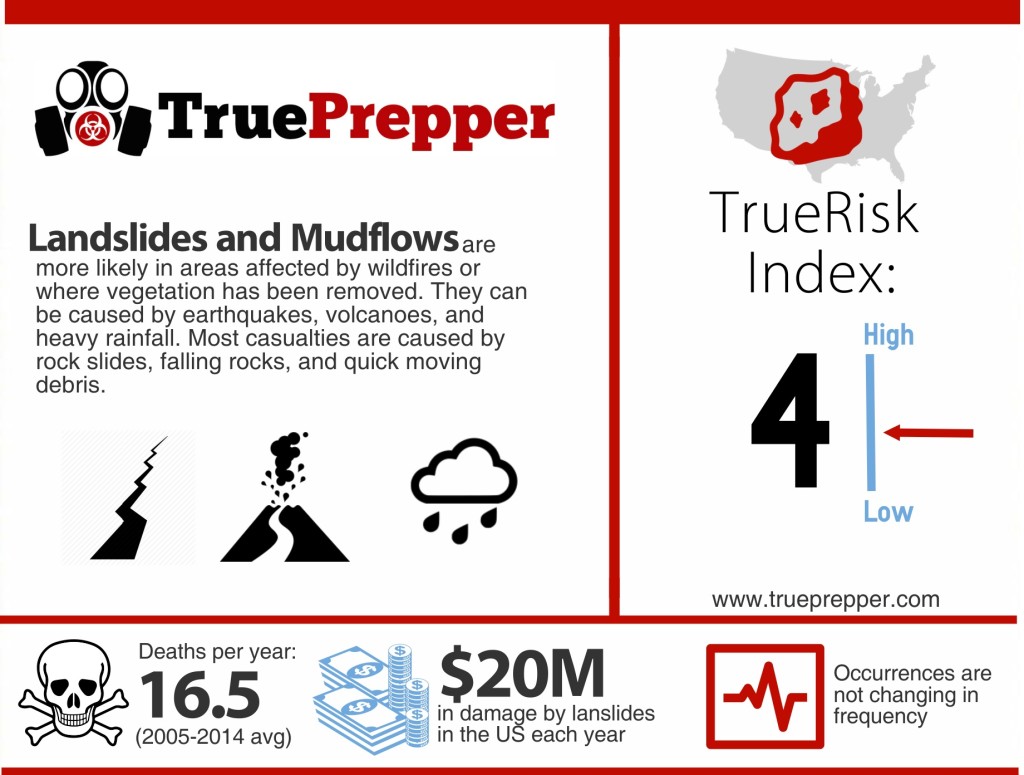
Severity of a Landslide
Can it cause TEOTWAWKI?
Determine Your Landslide Risk
Prepping for Landslides
Suggested Kits
Suggested Plans
During a Landslide
After a Landslide
Coastal Event

Tsunamis, storm surges, and rip currents can cause mass devastation and/or death. They all originate through combinations of the ocean and weather, but they are very different threats. All of these threats apply to those who are near the coast, on the coast, or in the ocean. This makes these threats very regional, and important to understand if you live in a possibly affected area.
- Tsunamis: These giant waves cause the most destruction of the three that we examined. Though they are fairly infrequent, they can plow through buildings easily and have an extended range. They can be caused by space weather, earthquakes, and volcanoes.
- Storm Surge: A temporary rise in sea level can put many buildings (and people for that matter) underwater. Storm surge is also far-reaching in many areas since most land near the coast is not that high in elevation. These temporary surges can be caused by severe storms and hurricanes.
- Rip Currents: These invisible killers claim the most lives per year of all three types of coastal incidents. While it only affects only a few people at a time rather than a whole community, they should not be overlooked as a threat. Those caught in a rip current can easily get pulled out to sea to drown. The threat is reserved for those swimming or wading in the water, but that does not make it any less deadly.
Severity of a Coastal Incident
The severity of a coastal incident can fall in a wide range. From a mega-tsunami to a small rip current, the scope, range, and impact can go from world-ending to barely a threat.
How Bad Can Coastal Incidents Get?
A mega-tsunami could certainly cause the end of the world as we know it. The distance a large tidal wave can travel inland is quite startling and would catch the majority of the people living in that area off guard. But besides a meteor or super volcano-induced tidal wave- the rest of the coastal incident threats are not quite so great.
Determine Your Coastal Incident Risk
The risk for a coastal incident is relatively high on the TrueRisk scale at a 4. Luckily, this threat is very geographically localized to the coast. Rip currents are extremely isolated, but are a naturally occurring phenomenon that can persist for long periods and easily claim lives. This makes them less severe of an incident, although deadly. Storm surge affects a larger area, but is usually predictable and has plenty of notice since it accompanies large storms. Tsunamis are deadly, affect a large area, and are usually part of a ‘domino effect’ of disasters. The combined threat of these incidents results in a risk level that should be noticed and prepared for if you live in a coastal area. If you live inland, only TEOTWAWKI coastal incidents would pose a threat.
Prepping for Coastal Incidents
The ability to bug out is one of the more important ways to be prepared for a coastal incident. Most severe incidents have warnings ahead of time, so staying informed can definitely give you a leg up on survival.
Suggested Kits
The main component you will need out of the survival kit is the communication supplies. Having these set up to notify you of any coastal incident warning will give you the much-needed time to use your bug out bag to escape the area. In the event of a rip current, the survival kit first aid component may be needed.
Suggested Plans
An evacuation plan, fondly known by preppers as a bug out plan, is very important to avoid becoming a casualty. A bug out plan, of course, is more comprehensive than your typical evacuation plan since it covers your end destination, equipment to bring, and a vehicle or plan to get you there.
- Bug Out Plan
During a Coastal Incident
The different coastal events require different actions. Knowing what to do during each of these events can greatly increase your chance of survival. If you are personally caught in a rip current, the most important thing to remember is to relax, locate the shoreline, and swim perpendicular to the shore to escape the current. Trying to fight the current, or swimming with the current will tire you and pull you further from safety. For both tsunamis and storm surges, evacuation is recommended if you receive advanced notice. If you cannot escape in time, it is best to get to higher ground and as far away from the beach as possible.
After a Coastal Incident
Recovering after the disaster will take some time and a little know-how. It varies based on the incident, but storm surges and tsunamis are similar whereas rip currents are different.
- Storm Surge/Tsunami Recovery: Assuming you evacuated, you will need to wait until the water subsides and the area around your home is safe. Once is it safe to return home, inspect the damage and note anything salvageable. You will want to contact your insurance company if you have one that covers these events.
- Rip Current Recovery: Administer first aid and/or CPR to the victim. If you were the victim, regain your breath and try to relax. Make sure authorities and others in the area know of the threat and avoid the water in the area.
Power Outage

Power outages are becoming more and more frequent as the power grid in the US ages. While steps have been made to protect the infrastructure and reduce loads on the grid, it is still stressed at peak times. Power outages can be fatal to those dependent on power, such as hospital residents. While a power outage is easy to mitigate with a generator or solar panel array, being prepared yourself may not be enough. The disruption caused to the masses is just as dangerous, as opportunists and burglars are on the roam with security systems and surveillance cameras obviously not working in most places. Be aware of your situation and your vulnerabilities and stay prepared for a power outage- whether it is brief or indefinite…
Severity of a Power Outage
Power outages have a wide range of severity. A power outage goes from insignificant to very severe the longer it goes on. The majority of the disruption is from the interference caused to the food supply. Food stores will spoil during long power outages and many people will become reliant on emergency assistance. The larger and longer the outage, the more people will be vulnerable. A power outage is usually the “icing on the cake” for other disasters and emergencies, putting vulnerable people in stressful situations.
How Bad Can a Power Outage Get?
While power outages in these scenarios are almost always a domino effect of another disaster or catastrophe, losing power indefinitely could and would change the world as we know it. Almost any disaster, attack, or accident can disrupt the power grid. Society’s reliance on power has grown by leaps and bounds in the computer age, and a long-term disruption would have catastrophic results and change the world. While there would have to be another event preventing the return of the power grid to ‘normal’, power would be sorely missed and affect society more and more as it is missing.
Determine Your Power Outage Risk
A power outage is a 3 on the TrueRisk index. A power outage, however, is a risk that you can mitigate to virtually zero. Generators, solar panels, and alternative power sources are all able to keep your power on while the rest of your region or world is in the dark. Those who have chosen to live ‘off-grid’ are already not reliant on power sourced from the ‘main grid’, which lowers their risk. There are still events that can cause a power outage regardless of your location or supply grid (looking at you, EMP). When determining your custom risk level, take a look at how often you get blackouts and brownouts on your grid and how your power is supplied. Exposed power lines can be repaired easier than buried lines, but have problems more often. Even if you are prepared and have your power situation covered, other’s unpreparedness will undoubtedly affect you as well. Looters and opportunists are usually on the prowl when the power goes out, and someone with power may be seen as a target.
Prepping for Power Outages
Before you get stuck in the dark, you should take a second to prepare for short-term and long-term power outages. A couple of things added to your staple kits and you should be good to go. The one good thing about power outages is they rarely cause issues immediately on their own, so you should have plenty of time to implement your plan and use your kit.
Suggested Kits
Your catch-all survival kit and your bug out bag should be equipped to handle power outages. Virtually every checklist for both of these kits covers this crucial area. Here are our two suggested kits for power outages:
Suggested Plans
Your basic emergency plan should be fine for a basic power outage. We list the bug out plan below in case the power outage is long-term or permanent and you have a bug out location set up for long-term survival. Use your best judgment when deciding which plan to implement. Here are the plans:
- Basic Emergency Plan
- Bug Out Plan
During a Power Outage
You will want to get to your survival kit and retrieve your candles, tea lights, and flashlights as quickly as safely possible. Once you are set up with a light source, you can move on to setting up any electrical workarounds you may have, such as temporary solar panels, generators, etc. Getting these online and making sure they are operational is important to understanding your limitations during the outage.
After a Power Outage
When the power outage is over, and power is restored be sure to inventory lost food and medicines and note any potential damage from the power being out. Lost food and damage can be claimed on insurance in many situations, so a call to an adjuster could be helpful. Complete an after-action assessment to see how well your kit equipment and your plans worked, and adjust them as you see fit. Many times the power grid is fragile after being restored, so do not be surprised if another outage quickly follows the power restoration.
HAZMAT Incident
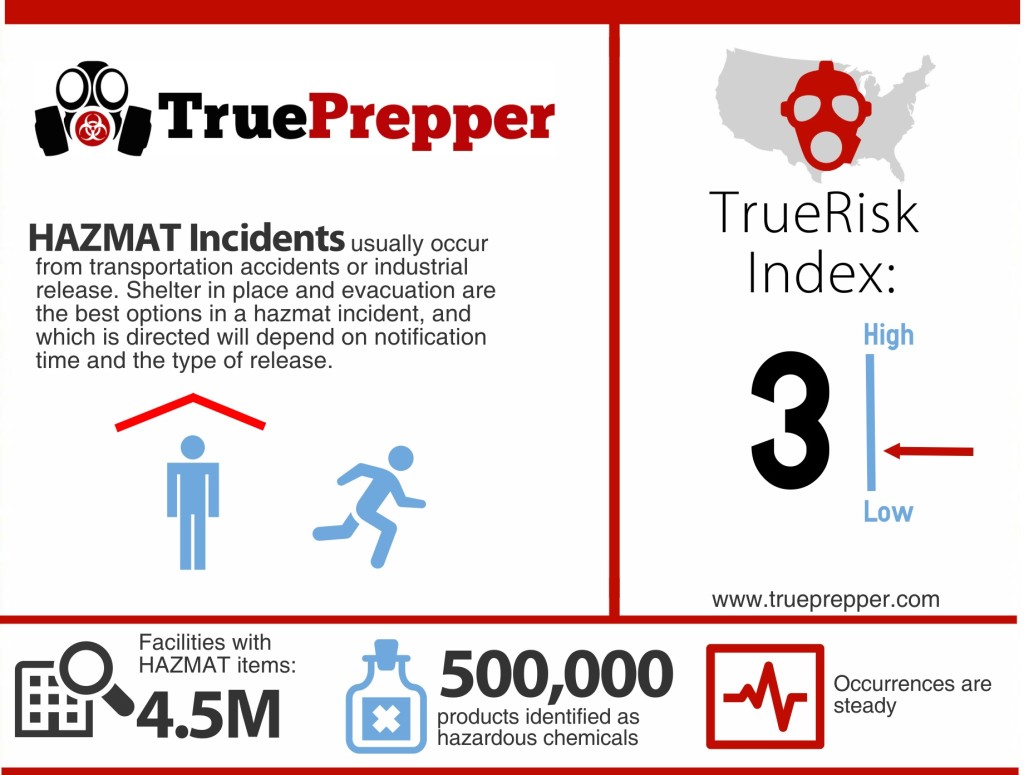
Hazardous Materials (HAZMATs) are found everywhere. They include all sorts of chemicals, fertilizers, and industrial materials- the list of all hazardous materials is huge. Most times they have handling restrictions to help prevent accidents in storage and transportation. Many times, anyone who handles them is expected to wear personal protective equipment. They are often found in industrial facilities, but can also be found in residential homes as well. Trucks, trains, and planes can transport these hazards through areas where they may not usually be found. HAZMAT materials can pose airborne, contact, ingestion, and radioactive threats so they are not always easily identified.
Industrial facilities have HAZMAT materials marked. Any material posing any type of risk (including non-HAZMAT) is listed in a Material Safety Data Sheet (MSDS) binder. Most homes do not have this level of identification and safety. Be sure you know where your hazardous materials are kept, and consider securing or marking them to avoid household incidents. Firefighters are usually trained in how to deal with HAZMAT emergencies, but many emergencies are unpredictable accidents where first responders may not be immediately on the scene.
Severity of a Hazardous Material Incident
HAZMAT incidents are typically localized and very fatal. The incidents occur quickly and also escalate quickly. Whether it is a simple accident occurring in a home, or a transportation disaster that affects a large area, the severity of injuries is usually linked to exposure time. While some chemicals give warning by being visible or with odors, many are invisible and odorless.
Determine Your HAZMAT Incident Risk
Although we have calculated a TrueRisk score of 3 for Hazardous Material Incidents, you will want to evaluate your risk for yourself. A 3 TrueRisk score means you are typically not at very high risk with a HAZMAT incident. However, your location and many other factors can determine your risk level. Check your local maps for industrial factories, or common transportation routes such as train tracks or major highways where HAZMAT items are transported. Maps, this information, and prevalent wind can help you complete your risk assessment. If you are typically downwind or downhill from any of these areas, you are at a much greater risk than average. Check out the Department of Transportation Pipeline and Hazardous Materials Safety Administration for information on HAZMAT incidents and who to call before you dig. (Hint: Call 811)
Prepping for HAZMAT Incidents
Planning for a HAZMAT incident can make all the difference in an emergency. The tools and resources you have combined with the plans you make can keep you alive and well. Becoming familiar with your kits and practicing your plans are both keys to being fully prepared.
Suggested HAZMAT Kits
Having the right resources at the right time is important when it comes to disasters and emergencies. Various kits can prepare you for the worst by letting you have the most resources at the ready. Our suggested kits for dealing with HAZMAT incidents include:
Suggested HAZMAT Incident Plans
Planning for a HAZMAT Incident is relatively simple. Many templates work just fine for any HAZMAT scenario. Check out these plans to be sure you are ready for an emergency:
- Basic Emergency Plan
- Shelter in Place Plan
- Bug Out Plan
During a HAZMAT Incident
When an incident occurs, you will likely have little to no time to be ready. Evacuation or shelter in place may be in order, depending on the circumstance. If you are asked to evacuate by officials, you should do so as quickly as possible, bringing your portable survival kits and/or bug out bags with you. Shut your doors and windows if there is time to avoid long-term contamination. If the incident occurs when you are outside, you should try to get uphill and upwind immediately. Avoid gas clouds, fumes, and smoke. If you are in your vehicle, you can evacuate, or shelter in place if you have the tools in your car to do so. If you are asked to stay put, follow your shelter-in-place plan as quickly as possible. A shelter-in-place directive instead of evacuation likely means your area is too high risk for evacuation and you will have to ‘ride it out’.
After a HAZMAT Incident
When the incident is over, the real work is just beginning. If you have been exposed to hazardous materials, you will need to seek medical attention quickly. If authorities have decontamination instructions, you should follow them immediately. Stay informed as much as possible about the incident and how to mitigate all of its effects. If you have been evacuated, authorities should let you know when it is safe to return home. Once you are home, you should ventilate your house and make sure there are no residual vapors or smells.
Space Weather

Severity of a Space Weather Event
How Bad Can Space Weather Get?
Determine Your Space Weather Risk
Prepping for Space Weather
Suggested Kits
Suggested Plans
During a Space Weather Event
After a Space Weather Event
Volcano
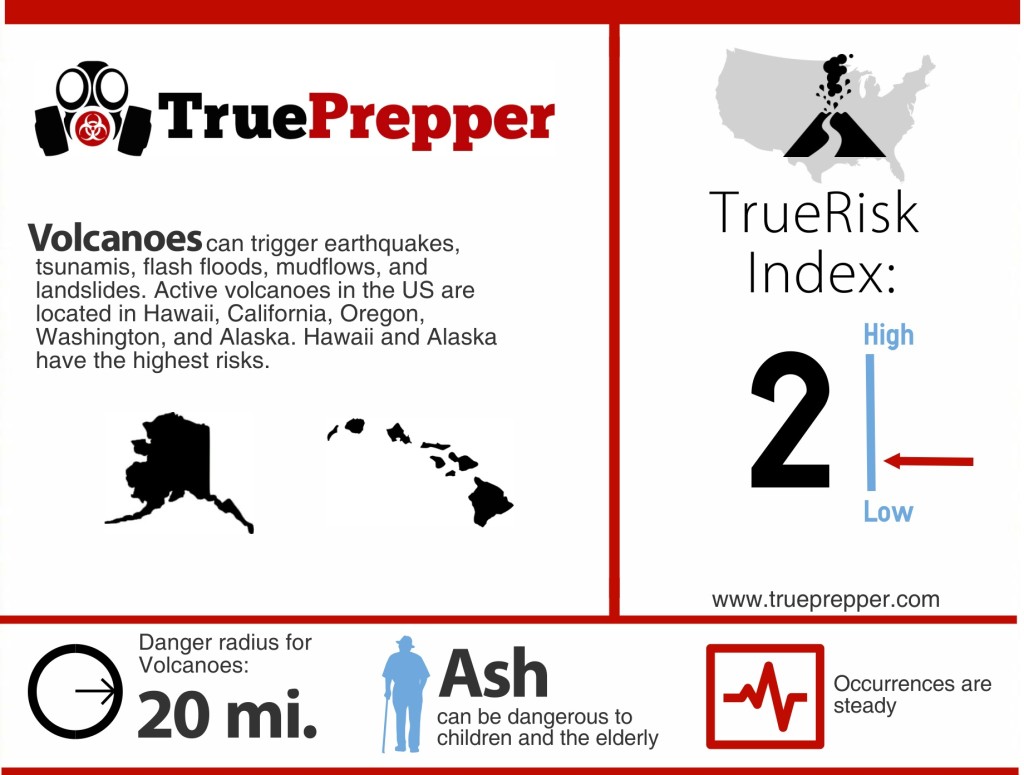
Severity of a Volcano Eruption
How Bad Can a Volcanic Eruption Be?
Determine Your Volcano Risk
Prepping for Volcanoes
Suggested Kits
Suggested Plans
During a Volcano Eruption
After a Volcano Eruption
Biological Attack
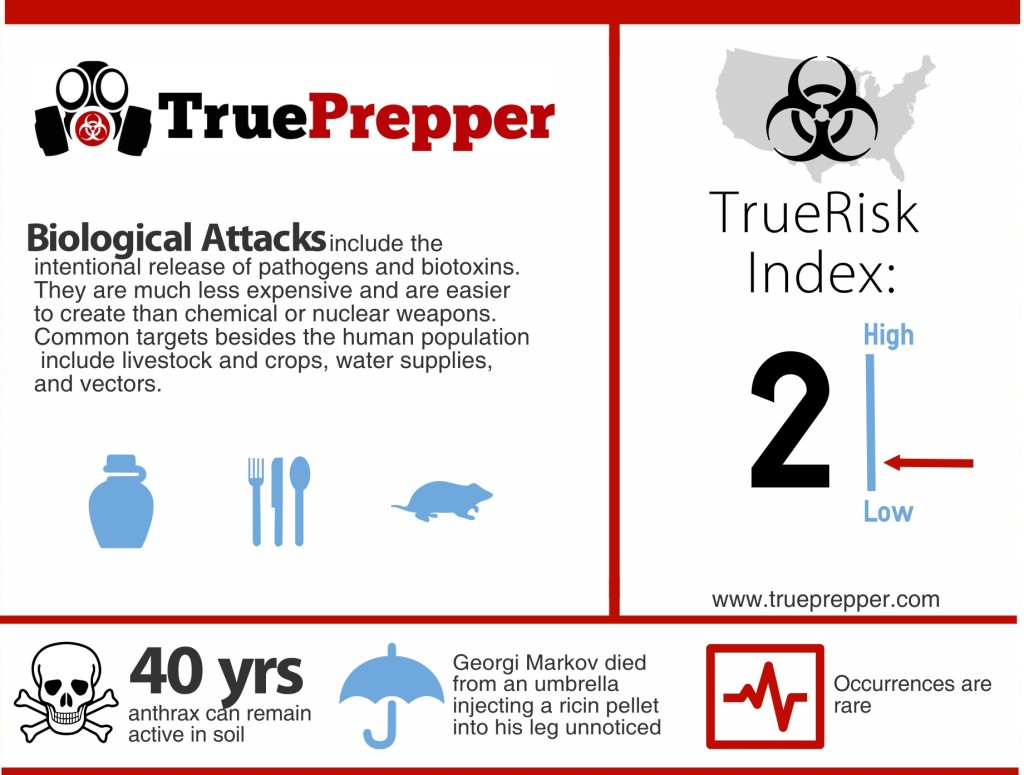
Let’s face it, biological attacks are the things nightmares are made of. Hollywood has been having a field day coming out with movies based on this vulnerability, ranging from campy zombie movies to the much more scientifically accurate Contagion. Biological attacks are the intentional release of bacteria, viruses, or toxins to disrupt society or kill people. The scale of an attack can range from a single person to putting virtually everyone in the world at risk. Biological weapons are relatively cheap to obtain or manufacture, making them appealing to underfunded terrorist cells or enemy states. They are different from chemical and nuclear attacks in that certain types of biological attacks can be contagious. Some of the more notorious biological weapons include ricin, anthrax, and smallpox (‘exterminated’ diseases are no longer vaccinated). Many attacks of these types would end up manifesting as widespread pandemics. Our TrueRisk index of course includes a section on prepping for pandemics.
Severity of a Biological Attack
The severity of a biological attack can vary widely- the widest span of severity we cover on the TrueRisk index. A single attack that merely inconveniences one person to a world-threatening biological weapon that cascades into a pandemic is the two extreme scenarios. The worst-case biological weapon would likely include these key features:
- Highly contagious
- Long incubation period
- Unknown to the medical community
- Easily transmitted through a vector
Any of these attributes drastically worsen a biological weapon’s potential severity. An attack with these markers would most likely end up being a pandemic- the most severe type of biological attack.
Can it cause TEOTWAWKI?
A biological attack is one of the more well-known SHTF scenarios, and it can definitely cause TEOTWAWKI. While there are mitigation plans in place through the CDC, FEMA, DHS, and DoD, (prepper acronyms explained) a biological weapon that contains most or all of the key features mentioned above could easily outspread any existing plan. A biological attack would most likely cause TEOTWAWKI to evolve into a pandemic.
Determine Your Biological Attack Risk
A biological attack shows up as a 2 on the TrueRisk index. While an attack could have devastating consequences, it can also be localized and even non-fatal. Mitigation plans are in place to prevent and cut short these attacks. The Strategic National Stockpile (SNS) is a cache of vaccines maintained by the US government for rapid deployment just in case of a biological attack. They also have plans in place to rapidly develop vaccines through resources in the World Health Organization (WHO) and Centers for Disease Control and Prevention (CDC). Estimating any increase or decrease in your personal risk level is very easy. Urban areas are much higher risk than rural areas and suburban areas are in between. Closer proximity to other people increases the likelihood of being a target in the first place but also increases the chance of infection if the biological attack is communicable. The risk difference between a natural pandemic and a targeted biological attack is pretty large. A biological attack is not necessarily a pandemic, meaning it can include attacks with lesser risks. Biological attacks have never manifested into a pandemic before, so it is not historically common either. There are detractors to using pandemic-level attacks for the attackers as well since biological weapons are indiscriminate.
Prepping for Biological Attacks
The movies in Hollywood never show people getting or being prepared for a biological attack. While biological attacks are very hard to detect until actual symptoms are shown, you can still prepare to encounter them. Personal protective equipment is key for venturing out where you could risk exposure. The best plan is to get away from populated areas and bug in. If you cannot get away, simply bugging in could prove effective. Avoiding contact with others is the best practice.
Suggested Kits
Staying protected during a biological attack requires a good amount of gear. It usually involves hunkering down either at home or your bug out location, which will determine your kits needed. Plenty of food storage and personal protection will be needed.
- Survival Kit
- Bug Out Bag
- Get Home Bag
- Specialized Kit – Personal Protection
Suggested Plans
There are two basic plans you should consider when confronted with a biological attack. The bug out plan is for when your current situation is maybe a little too ‘urban’ to try and survive through a pandemic. Getting to a remote location may provide you with better survival odds, assuming you can get to the alternate location safely. Otherwise, you would want to stay put and survive off of your food storage. Here are the suggested plans:
- Bug Out Plan
- Bug In Plan
During a Biological Attack
A biological attack may or may not have a warning or prior notice, depending on the vector used to disperse the attack agent. Most of the time there would be no warnings since groups will choose biological attacks for the ‘surprise factor’ of the attacks. These attacks will strike fear into the very heart of society and cause all sorts of panic. The best thing to do during an attack is to limit your exposure to others. There is not a whole lot of good that can come from coming in contact with other people during a biological attack, and you will want to stay isolated and informed on the situation. Learning the scope of the attack is important because then you can determine about how long you can expect to stay away from others. Anything less than a pandemic should have some semblance of normal society return once the infection rate is no longer growing.
After a Biological Attack
Some biological weapons can survive for long periods on clothing and other inanimate objects. They can flourish for long periods in animals and other living matter. Be wary and do not become complacent after an attack, as many biological weapons can show resurgence once people think they are ‘out of the woods.’ Be sure to practice proper hygiene and remind those around you to practice good hygiene as well. If you had any belongings come into direct contact with a biological agent, you would want to use bleach, charcoal, or fire and dispose of it. This would be extremely unlikely unless you were patient zero, or the first person targeted by the attack.
Nuclear Accident
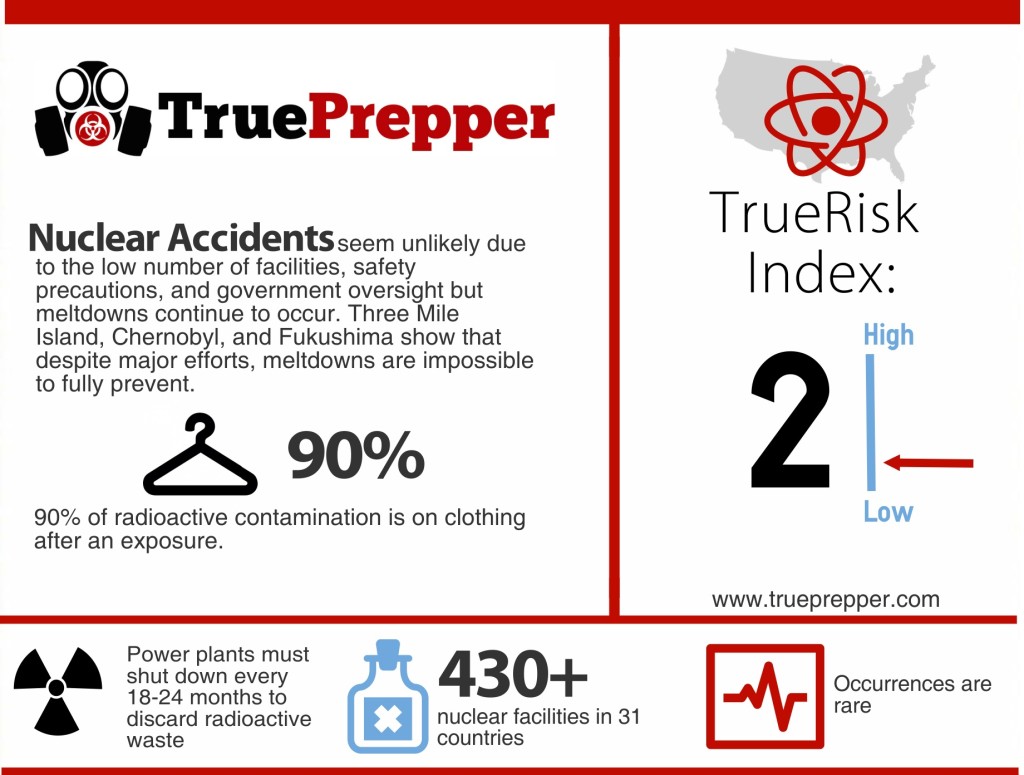
Nuclear accidents have happened and can happen at any nuclear site. Chornobyl, Three Mile Island, and Fukushima are all prime examples of nuclear mishaps. Even the most redundant of safety precautions can be compromised, and in the worst cases cause a nuclear meltdown. It is important to know your proximity to nuclear power plants and prevalent winds for your area as well since nuclear fallout can easily travel hundreds of miles through the atmosphere. Nuclear accidents can also happen with nuclear warheads. The military has surprisingly mishandled quite a few warheads, and even lost some permanently! A nuclear accident would result in either a nuclear detonation or a radiation leak. The radiation leak accidents are more common, but the detonation accidents are much more severe and give less notice.
Severity of a Nuclear Accident
Nuclear accidents have one type: severe. Whether it is a detonation or a radiation leak, a single nuclear accident likely has the potential to kill millions. Even if they do not historically claim large death tolls, it is merely due to the advanced notice we receive and the ability to evacuate. The radiation spilled is no less severe, and often taints the land making it unlivable for centuries to come. There have been narrow misses, such as Three Mile Island, that are still considered nuclear accidents without as much catastrophic destruction as you might expect.
Can it cause TEOTWAWKI?
A single nuclear accident cannot cause TEOTWAWKI, although it can empty cities and displace people for hundreds of miles. If multiple accidents were to occur in close proximity and around the same time, society might have a difficult time recovering. This would be much more likely to occur as a result of an attack. A nuclear attack is a scenario you should be anticipating as a world-changing event, rather than a nuclear accident. A nuclear accident is currently much more likely to occur than a nuclear attack, however.
Determine Your Nuclear Accident Risk
A nuclear accident registers on the TrueRisk index as a 2. This risk can be elevated based on your proximity to a nuclear reactor or nuclear weapon assets typically stored on US Air Force bases. It may seem odd at first, that nuclear accidents are higher risk than attacks. Although coordinated nuclear attacks would fracture our society to the core, nuclear accidents are simply more likely and still pose a wide-scale danger. It also seems odd to assume that, as humans, we are more likely to mess up and have an ‘accident’ than to intentionally nuke each other. History shows, even as recently as Fukushima, that that is simply the case. The calculated risk of a nuclear accident truly does outweigh the calculated risk of a nuclear attack due to the many nuclear accident occurrences that have already happened and will happen. Determining your risk requires a good deal of map checking. You will need to check your proximity to nuclear power plants and military bases. Assume that any military base with a protected runway could be transporting fissile material, especially Air Force bases. Once you have those marked on the map near your home, you need to check the prevailing winds for your area and for the bases and power plants. If you are downwind from either of these facilities, you are at a higher risk for a nuclear accident. Just because you are not downwind does not exclude you, as wind can decide to blow in different directions and the Air Force has lost several nuclear bombs in transport. No home is 100% safe from a nuclear accident (unless you live in a fallout shelter). The last thing you need to check for is earthquake seismic activity. If you live in an active area and live near a reactor, your risk is even more elevated. Check the map below for overlapping seismic and nuclear hazards.
Prepping for Nuclear Accidents
Getting prepared for a nuclear accident is much easier than it sounds. Determining your risk level, as shown above, is the tough part. If you are in a high-risk area, a bug out bag may be your best bet. Nuclear accidents at least give a fair amount of warning before the catastrophe occurs, and evacuations are usually successful. If you have the means to prep with a bunker or fallout shelter, then that is even better. A stocked bunker will be needed for long periods of habitation, if you plan on using it.
Suggested Kits
Your basic survival kit, bug out bag, and a shelter-in-place kit should be the bare minimum. The shelter-in-place kit is very limited for radiation, so it should not be something you plan on relying on for long. A radiation protection kit usually is just filled with personal protective equipment for radiation, but that can help a good bit if you are in a very high-risk area. Here are the suggested nuclear accident kits:
- Survival Kit
- Bug Out Bag
- Specialized Kits – Radiation Protection, Shelter in Place
Suggested Plans
We suggest three very different plans based on your situation and the resources you have. The bug out plan is almost always preferred, simply because radiation itself is hard to deal with on a constant basis. The constant decontamination required for a low-budget bunker plan and the limited timetable of a shelter-in-place plan make those plans much harder to execute. Nevertheless, here are the suggested nuclear accident plans:
- Bug Out Plan
- Bunker Plan
- Shelter in Place
During a Nuclear Accident
There will be advanced notice prior to an accidental nuclear detonation or radiation leak. This is mainly the case with nuclear power plants, since military assets are much more unpredictable and would likely not have any notice. The first wave would be the shockwave, which travels both outward and inward from the blast, similar to an ocean wave. Once that has passed, if you are in the range of the fireball, you will likely not survive but should attempt to find shelter behind a sturdy structure made out of concrete or cinder blocks. The survival rate of those exposed to blasts is not high, but attempting to survive is better than not. After the fireball, the fallout falls through the atmosphere and is carried downwind for hundreds of miles. This is historically the most deadly part of a nuclear explosion, due to the number of victims of the fallout effects. You will want to protect your skin and your face from the radiation fallout with gas masks and radiation suits from your kits. Leaving the area should be your number one priority, and moving at a right angle from the direction of the accident is the quickest way. A radiation leak performs similarly to fallout but is invisible, slower moving, and smaller in area. The same kit that keeps you safe from a nuclear explosion would keep you safe from a radiation leak.
After a Nuclear Accident
If you have been exposed to radiation, you will need to decontaminate yourself and change your clothing. You should seek medical attention where you may be administered tablets to help absorb the radiation you have been exposed to. If you are lucky to have survived a nuclear accident that affected your home, you will still need to permanently relocate. Radiation is usually covered up as it is very difficult to decontaminate from large areas. Even then, it will be centuries before the area returns to a habitable place once again.
Electromagnetic Pulse (EMP)
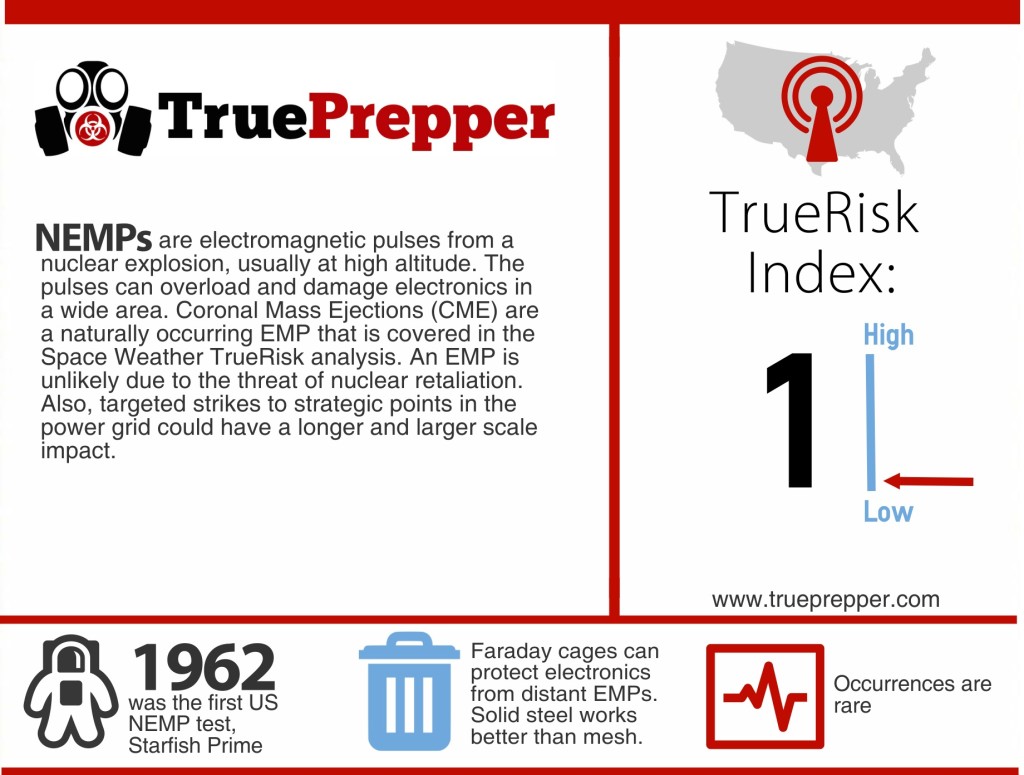
An electromagnetic pulse is a surge of electromagnetic energy that can disrupt and permanently damage electronics. For the purposes of conducting our risk analysis, we separated the causes of electromagnetic pulses into two categories, and focus on one in this section. The cause we do not cover in this section is the Coronal Mass Ejection (CME), which we cover under our TrueRisk evaluation for space weather. We will be focusing on nuclear-caused EMPs, also known as NEMPs (Nuclear Electromagnetic Pulses). While both have a high potential severity in our electronic-dependent society, the fact that one is man-made and one is naturally occurring presents a much different risk calculation for the two events. A nuclear EMP causes three distinct pulses that present a threat:
- E1: the fastest pulse produced by gamma radiation ionizing the upper atmosphere travels at 90% of the speed of light and is the most destructive pulse. Weaponized “Super EMPs” are reportedly able to exceed 50,000 volts per meter which makes the E1 pulse effective on virtually any electronic device, but this is unconfirmed and possibly classified. Regardless, the E1 pulse travels faster than most surge protectors are able to operate.
- E2: the intermediate pulse is produced from gamma rays and neutrons and is similar to the surge produced by lightning. Because of this, protection designed for lightning also protects well against the E2 pulse.
- E3: the slowest pulse that can last hundreds of seconds after a detonation. This is caused by a temporary distortion in the Earth’s magnetic field. It is similar to a solar flare or coronal mass ejection. Long electrical conductors such as power lines and transformers will be damaged by an E3 pulse.
Severity of an EMP
The TrueRisk index puts an EMP risk as a 1. This does not mean that the risk is negligible or non-existent, it merely means the other risks on the index are prioritized. An EMP-driven TEOTWAWKI event has been somewhat romanticized by some preppers, but the data shows that the chances of one occurring deliberately are on the low end of the scale. One of the major factors related to this low ranking is that an EMP event does not cause direct harm to life and limb, such as a ground burst nuclear strike. The fact that NEMPs are viewed by the Department of Defense as a nuclear attack, and therefore subject to nuclear retaliation strikes makes the odds of an enemy country using one very low. Military hardening against EMPs and resource dispersal over the years has ensured that retaliation will be able to take place. That said, if a group were bold enough to use an EMP, they would target large urban areas or military sites. If you live close to either of these areas, your risk of exposure to an EMP is slightly elevated since your own electronics would be affected. The majority of the risk of an EMP is not tied to your own electronics, but to the electronics that sustain society at power plants, water treatment facilities, and food distribution.
Prepping for Electromagnetic Pulses
EMPs are relatively simple to prepare for. As with many attacks and disasters, basic survival kits and plans are the cornerstone. Hardening your personal electronics using Faraday cages can help, but a low priority when looking at the possible damage on a larger scale. EMPs can disable vehicles, so being able to return to your home if your vehicle becomes disabled should be planned for as well.
Suggested Kits
Prioritize a survival kit over all other kits when preparing for an EMP. Disruption to supply chains, water supply, and the electric grid is the highest impact result of an electromagnetic pulse. Electrical hardening includes resilient electronics and Faraday cages, for the most part.
- Survival Kit
- Bug Out Bag
- Get Home Bag
- Specialized Kits – Electrical Hardening
Suggested Plans
Electromagnetic pulses can cause all sorts of damage and chaos, but they aren’t as dangerous to your life as other TEOTWAWKI events. A solid bug in and/or bug out plan that is flexible should be enough to handle an isolated event. If it is a wide-scale attack, being resourceful and flexible to change with the future is the best plan.
- Bug Out Plan
- Bug In Plan
During an Electromagnetic Pulse
NEMPs are a result of a nuclear detonation so you first need to be concerned with the ‘detonation’ part of the equation. Know that a shockwave can still be present and seek cover immediately if you have any forewarning. If you need to get equipment into a Faraday cage, you need to act very quickly depending on how much notice you have until detonation. The NEMP is composed of three components: E1, E2, and E3, so you should be prepared to stay protected through all three components and distance yourself from electronics.
After an Electromagnetic Pulse
Check the status of yourself and your family first- do not assume that no harm can come from the blast. Ensure that the EMP discharge is complete by waiting several minutes after the blast. Once you have accounted for everyone and everything that is vital to survival, you can begin testing your electronics. Visually inspect for damage before trying to power on any devices.
Communications equipment is particularly susceptible to EMPs but important to obtain information in survival scenarios. If your communication equipment is working, it is a good idea to try and determine the extent of the damage to other’s equipment to get a bearing on how bad the attack was.
Sources and References
One of the best sources on EMP threat to US infrastructure is the Metatech Impact Assessment conducted for the Oak Ridge National Lab in 2010. It is very thorough and even addresses misconceptions in the last few pages.
Nuclear Attack

Two nuclear attacks have ever occurred throughout history, and both were bombs dropped by the U.S. to end World War II. While these weapons of mass destruction have been depicted as the ultimate world destroyers in fiction novels and movies, the apparent risk is not as high as it may seem at first.
Severity of a Nuclear Attack
A nuclear attack does have a range of severity it could fall within- but all of them are pretty severe. Isolated nuclear attacks would be highly unlikely at this point, and an exchanged volley of nuclear warheads between nuclear powers holds the very severe result of nuclear winter.
Can it cause TEOTWAWKI?
Yes. A nuclear winter is one of the more common and unpleasant SHTF/TEOTWAWKI events prepared for by preppers. A volley between superpowers with nuclear weapons would not only kill off ¼ of the world population in an instant but severely damage the atmosphere of the earth as well. Although nuclear weapons are not produced at the same rate as they once were, there are still enough of them to end the world as we know it.
Determine Your Nuclear Attack Risk
A nuclear attack is calculated at the top end of a 1 on the TrueRisk index. There should be caution here, because this is a 1 and not a zero, and the risk should not be ignored. Now many may argue that the risk is much higher than this, but I would encourage them to look objectively at the scale. A few insights into why the risk is lower than say, a pandemic:
- The data points to only two occurrences separated from us by about 70 years.
- There is a strong deterrence to using nuclear warheads due to the ‘retaliation guarantee.’
- Nuclear anti-proliferation has been a priority of all nuclear superpowers.
- Tactical nuclear strikes are much preferred by enemy states over large weapons
The way nuclear weapons have evolved into tactical strike weapons puts everyone at a lesser risk, unless you reside in a high population area, near a military installation, or in an industrial area. Prevalent winds also play a role in your risk of radiation exposure, since fallout can be just as deadly as the blast and can reach much further.
Prepping for Nuclear Attacks
There are several ways you could be prepping for a nuclear attack. Besides your catch-all survival kit and bug out bag, personal protection could be acquired and you could even invest in a fallout shelter.
Suggested Kits
Preparing for a nuclear event requires a good amount of gear. While most of it is your generic survival gear that you will use for disasters and other events, there is some specialized gear that will come in handy. Be sure you have everything in order before the unlikely becomes reality.
- Survival Kit
- Bug Out Bag
- Get Home Bag
- Specialized Kits – Personal Protection, Radiation Detection
Suggested Plans
You may want to have a ‘get out of dodge’ bug out plan in your back pocket, depending on your location. I know most preppers, despite their wishes, do not own or have access to a bunker, but that is truly the ideal plan for a nuclear event. If you are far enough away from threat areas and not downwind from them, you may not need to prioritize a bug out plan specifically for a nuclear attack.
- Bug Out Plan
- Bunker Plan
During a Nuclear Attack
Shield yourself from the blast. First, there is a shockwave which will blow out windows and knock over smaller objects and buildings. This shockwave is powerful enough to kill, so minimizing your exposure immediately should be your priority. Depending on your proximity, the fireball or the blowback is next. The fireball is literally that- a ball of fire that consumes the impact point in a small radius. Much like a conventional bomb, there is not much hope if you are at the impact point of a nuclear weapon. The blowback is the original shockwave returning to the center of the blast point, which carries almost as much force as the original shockwave. Once you are shielded, if you have personal protective equipment (PPE), put it on immediately. Depending on the nuclear weapon’s proximity to the ground, radioactive debris will be kicked up into the air, also known as ‘fallout’. Detonations slightly above the ground produce the most fallout, and this can have the furthest-reaching impact with permanent radiation contamination. Nuclear tests in the atmosphere, below ground, and underwater all have different effects but produce much less fallout. Atmosphere detonations are usually attempted to increase the range of the electromagnetic pulse produced by the explosions- which still occurs at ground level, just at a lesser range. You can learn more about EMPs and how to prepare for this blast here: TrueRisk EMP.
After a Nuclear Attack
Entire series of movies, apocalyptic fiction, and video games are based on the after-effects of a nuclear attack. Whether it is a single tactical nuclear strike, or a world-ending volley between superpowers, the immediate widespread invisible threat is the same: radiation. Staying shielded from radiation will be one of the most important parts of survival post-nuclear strike. Radiation can contaminate the soil, wildlife, food storage, water, and of course, people. Detection and protection are very important, and hopefully, you had the foresight or luck to acquire both.
Conventional Attack

A conventional attack, for our risk analysis purposes, is considered a state-sponsored attack on the American homefront. In most cases, this would be a declaration of war using conventional weapons (instead of a nuclear war). We have had this occur in the past many times, with the last being Pearl Harbor in World War II. We also factored in the popular conspiracy theory of the government turning on its people and attacking them. While highly unlikely in any event, it is still safe to say that nothing is impossible. There have been six wars on US soil, or at places that would become the US throughout history:
- The American Revolutionary War
- The Civil War
- The War of 1812
- World War II
- The Mexican-American War
- The French and Indian War
History shows that war is always a distinct possibility despite the advances the US has shown in the security of the nation. American diplomacy is constantly changing and our stance in the world is constantly evolving, but the bottom line is that the threat of a conventional attack to America has grown smaller and smaller.
Severity of a Conventional Attack
As history shows, a war would prove to be bloody and brutal. Over a million people have died throughout wars, just on the American side. The stakes have only grown as conventional weapons have become more efficient killing machines. Any war that is kicked off on the homefront would have extremely severe consequences and cause a large number of casualties.
Can it cause TEOTWAWKI?
Yes. An invasion on home soil would change the world as all Americans know it and alter the course of our future forever. For another nation to have the audacity to challenge the US would mean they believe there is a chance to win. This means that they know something that we do not, or that our situation has been drastically changed.
Determine Your Conventional Attack Risk
A conventional attack is just a 1 on the TrueRisk index. As a reminder, the TrueRisk index is scaled based on threats to the United States, as this risk can be much higher for many other countries. If you live outside of the US or just prefer to assess your own risk levels, we encourage it by all means. Why is a conventional attack just a 1? There are three key reasons why the risk of invasion on US soil is so low:
- The Second Amendment – The US simply has the best-armed civilians in the world. With an unmatched 32% of households owning guns, an instant militia would be easy to create. The average gun-owning household has 8.1 firearms.
- Nuclear Authority – This does not just include the nuclear threat the US wields over other countries, but this includes the fact that it would be much easier for a nuclear warhead-wielding country to bomb the US than invade.
- Economy Diplomacy – Whether we are intimidating or accommodating, the driving force in this world is the economy. Since the last attack on American soil, the world has evolved into an interconnected economy with the US at the top. The economic situation would have to change drastically for any foreign superpower to consider challenging the US on American soil.
Prepping for Conventional Attacks
Preparing for war as a non-combatant can be confusing and scary at the same time. While self-defense and security will be at a premium, note that supply chains and infrastructure is often targeted as well.
Suggested Kits
Your survival kit should be more than ready to help you survive any loss in your resource supply chain. Pair that with a bug out bag “just in case” and you should be good to go. Make sure your survival kit has plenty of security provisions.
Suggested Plans
You will need to stay flexible with your planning, so creating specialized plans is not advised. The generic bug out/bug in plans should suffice in the event of a conventional attack.
- Bug Out Plan
- Bug In Plan
During a Conventional Attack
First things first- you will want to disengage from any area near any front line. Communication is always the key to knowing what is going on, where the enemy is, and how to escape. American forces will likely be evacuating cities under duress, and you need to be ready to leave with little notice. If you are not near the foray, you still need to stay updated using whatever communication means is available.
After a Conventional Attack
When the war or attack is over, you will be able to return home only when the military deems it safe and accessible. Stay informed and vigilant- strife and skirmishes are still possible and very much a threat. Rebuilding your life will be difficult and there will be many challenges. Be wary of ‘carpetbaggers’ who will come to take advantage of everyone in weaker bargaining positions. Stay positive, remember your priorities, and be thankful that you survived what will likely go in history books as World War III.
Chemical Attack

Though rare, chemical attacks can be deadly and target large areas. There are many different types of chemical weapons, ranging from common riot control tear gas to the deadly nerve agent Vx. All of these are prohibited for use in warfare due to the Chemical Weapons Convention (CWC) that the majority of countries in the world have ratified. Many countries that sponsor terrorist states have not ratified this treaty, however. Chemical weapons can be broken down into several categories:
- Riot Agents – These are less-lethal chemical agents that are often used for crowd control. CS gas and basic pepper spray are the most well-known types.
- Blister Agents – These chemicals cause large puss-filled blisters to develop on those exposed. They can cause death from skin exposure or inhalation. The most commonly known type is Mustard gas.
- Blood Agents – These agents are less common but are very hard to detect. They are fact-acting poisons that are colorless gasses with very little odor. Blood agents are absorbed into the bloodstream and prevent the blood cells from absorbing oxygen. Hydrogen cyanide is the best-known example of a blood agent.
- Choking Agents – These chemical agents prevent the lungs from absorbing oxygen, causing a ‘drowning’ type of death. Phosgene and Chlorine are both good examples of choking agents, but accidental chlorine spills are classified as HAZMAT accidents rather than chemical attacks.
- Nerve Agents – These agents are deadly in extremely small concentrations- some can kill with a drop the size of the end of a pin. They cause convulsions and seizures that end in death. The most commonly known types are Sarin (used about 10 years ago in a Tokyo subway attack) and Vx (recently used to kill the brother of Kim Jong Il, the leader of North Korea).
Chemical attacks can be planned out with SCUD missiles or a can of pepper spray, and the effects can vary just as widely too. While attack occurrences and stockpiles of chemical weapons have both been steadily dropping, the threat is still present.
Severity of a Chemical Attack
The severity of a chemical attack depends on many different conditions. The type of chemical, the way it is dispersed, and the targets can all affect the severity of the attack. The worst-case severity would be a series of coordinated nerve agent attacks dispersed with cluster bombs over a large urban area. Lesser known avenues of attack would also include attacking livestock, crops, and water sources. A chemical attack on food or water infrastructure could have dire consequences on the population.
Can it cause TEOTWAWKI?
Coordinated chemical attacks could cause deaths in the millions. There was at one time enough nerve agent to easily kill every living person, but anti-proliferation efforts have burned much of the known stockpiles. While it is possible TEOTWAWKI could be caused by a series of coordinated chemical attacks, it is extremely unlikely and impractical. Chemicals cannot spread like biological weapons and are less destructive than nuclear weapons. The mechanism to effectively disperse widespread lethal chemicals would just as effectively deliver nuclear or biological weapons which would likely have a greater impact.
Determine Your Chemical Attack Risk
Chemical attack risk is very low with a 1 on the TrueRisk index. The weapons of choice for nations have become nuclear weapons due to the ability to precisely target and the immediate effect. Chemical weapons are not typically favored by terrorists because they are too costly to develop and maintain. A biological weapons program is much cheaper, and a nuclear program is much more effective. Chemical attacks settle in the middle range area where they are really only cost-effective as a surprise attack, assassination attempt, or when used from old munitions supplies. Attacking food or water supplies with chemicals is planned against with monitoring at most processing facilities. This is also less of a risk simply due to biological attacks being better suited for this as well. Your risk of chemical attack goes up very slightly if you live in urban areas or near a military installation.
Prepping for Chemical Attacks
Luckily, chemical weapons can be prepared for. Personal protection in the form of gas masks and full-coverage clothing can do wonders. Shelter in place is a particularly effective plan for chemical attacks since most chemical weapons do not persist for very long when exposed to air. Prepping for chemical attacks may be simple, but it requires diligence in practice to avoid contamination.
Suggested Kits
A cheap shelter-in-place kit is going to be the most important gear to own to ride out a chemical attack. A close second would be personal protective equipment. These kits are needed to even consider using your basic survival kit and/or bug out bag.
Suggested Plans
If you plan on staying put during a chemical attack, you better have a shelter-in-place plan. Your bug-in plan simply won’t work if you cannot prevent the chemicals from getting into your shelter. The bug out plan is an alternative plan that you can resort to if the chemical is persistent or if your shelter is compromised. Having all three plans listed below is ideal:
- Bug Out Plan
- Bug In Plan
During a Chemical Attack
Stay calm and don your PPE if you have it. The next step is to make a quick decision on whether to bug out or shelter in place. If you are not near the detonation point, you may have time to leave the area if you deem that the best course of action. Sheltering in place may be an option if you have the tools to do so. Turn off all HVAC and fans, and tape up all entry points with plastic sheeting to make the room airtight. Rooms at higher elevations are usually better since most chemical agents are heavier than air. Setting up a room at a second story or higher is preferable to ground level. Bugging out should be done perpendicular to the wind direction. If the wind is blowing hard enough, you may not be able to outrun the attack downwind.
After a Chemical Attack
Most chemical agents will evaporate and dissipate within 72 hours. If they were disseminated in liquid form they may last slightly longer. Decontaminating all essential gear that was exposed should be a priority. Weathering is a great method of decontamination, but if you do not have time to expose the equipment to the elements, charcoal absorption, bleach baths, and other methods could be used.
Radiation Emitting Device (RED/RDD)
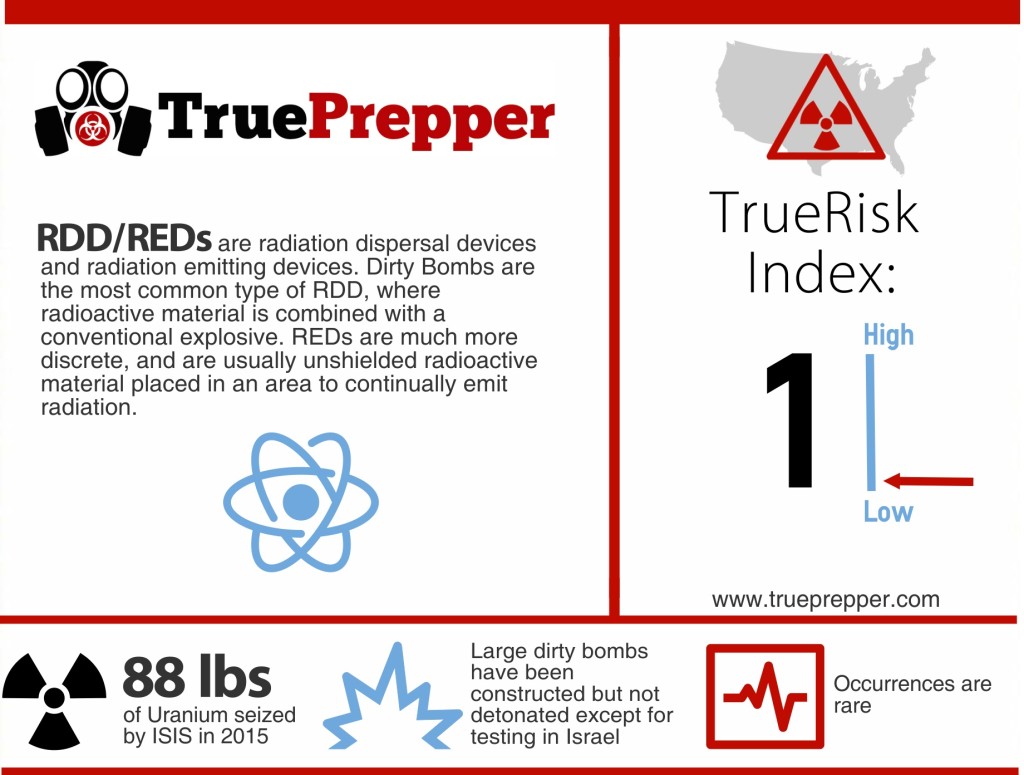
RDDs and REDs are similar enough to categorize together, but are very different threats.
- RDD stands for Radiological Dispersal Device. These are usually a “dirty bomb”, or a conventional explosive combined with radioactive material. They are a shock and awe-type weapon with lasting repercussions and damage. The perpetrators would usually claim responsibility for an RDD “dirty bomb”.
- RED stands for Radiological Emitting Device. These are usually unshielded radioactive materials placed in a hidden area meant to do damage over a long period. They are a silent and sneaky weapon, usually reserved for assassination attempts and silent attacks against fixed areas. The attacker would usually not claim responsibility due to the hidden nature of a RED.
A RED is very different from a Dirty Bomb. Dirty Bombs and their consequences are widely known, and response plans are in place for most civilized countries if an incident of a dirty bomb were to take place. Authorities responding to the Boston Marathon bombing took precautions responding to the attack due to the risk of it being a dirty bomb rather than a conventional bomb. It turned out to be a conventional pressure pot bomb, but they were ready to deal with it as a dirty bomb nonetheless. A dirty bomb is usually a conventional bomb with radioactive material packed around it to contaminate large areas. Dirty bombs are made to strike fear since they are not very common and have a longer-lasting impact than conventional bombs.
On the other hand, a radiological emitting device has almost the opposite effect. Despite using radioactive material and being a three-letter acronym, REDs are a much different animal. REDs deal their damage over longer periods and can be very hard to detect, making them a specialized type of threat. Easily obtainable radioactive material could be placed close to a person for long periods or repeated exposure to cause radiation poisoning and greatly increase their risk of cancer.
Placing any unshielded radioactive material in a common place where it would be difficult to find could expose a single individual or groups of people based on location to lethal levels of radiation cumulatively. Some places material could be hidden that would be extremely hard to locate for an individual attack:
- Inside a mattress (long, repeated exposure)
- Inside a car (repeated, frequent exposure)
- Inside clothing or accessories (small amount, long exposure)
Place material could be hidden for a group attack:
- Above a false ceiling (long exposure)
- Inside a wall (long exposure)
- In a backpack in a crowded area (many exposed)
- Beneath a liner in a trash can in a crowded area (many exposed)
Severity of an RDD/RED Attack
While both devices are lethal weapons, they are not as severe as others due to their limited size and effectiveness. The instantly lethal portion of an RDD is the release mechanism- usually an explosive. The remaining radiation exposure can be treated medically and prevented by staying away from the affected area. A RED, while difficult to detect, does not pose any instant threat and requires multiple exposures or prolonged exposure to do significant bodily harm. While radiation exposure can kill, there is also the possibility that radiation sickness symptoms will develop before a lethal dose of radiation is received, which will allow the victim to get away from the device. Neither device can affect a large area, region, or entire country which makes them have a limited severity. The major implications of an RDD or RED attack would be the surprise factor and the elevated fear factor of a radiation release.
Can it cause TEOTWAWKI?
No. As mentioned before when taking a look at the severity, an RDD or RED has a limited scope and range. While the terror aspect of an attack can send shockwaves through a community, it will not be enough to cause destabilization of society.
Determine Your RDD/RED Attack Risk
An RDD and RED risk calculates out to a 1 on the TrueRisk index. Although there is still a risk, this is one of the lowest calculated risks on the index- below all of the others listed at 1. The reason the RDD and RED risk is so small is due to several factors:
- Relatively Unknown: Not many attackers know about these devices, but responders are educated on them
- Difficult to Create: Getting a hold of nuclear materials and the means to disperse them is not the easiest task. Creating biological or chemical weapons is much easier for those without many resources.
- Difficult to Deploy: Both types are hard to get into position. An unshielded high-powered RED or RDD could kill the would-be attacker before it is even set up.
- Easy to Mitigate: Dirty bombs are mitigated by evacuating the area and cleaning it for radioactive debris. While difficult, it can be accomplished. REDs are mitigated by locating, identifying, and containing the device.
Your specific RED risk is based largely on your standing in your community and your job type. Public figures and government/military officials are at a slightly higher risk. RDD’s dirty bomb risk is tied to urban areas and military installations. If you are located in one of those two areas, your risk is slightly elevated for an RDD attack.
Prepping for RDD/REDs
The nature of RDDs and REDs makes them meant to catch you off guard. Planning for incidents and specialized kits are some of the more important preps for dealing with these threats.
Suggested Kits
Identifying whether or not an incident involves radiation is a difficult task. The Boston Marathon bombing was feared to have been a dirty bomb for a period of time after the attack, which slowed the overall response to the incident. Radiation protection and detection equipment really come in handy for these types of attacks.
- Home Survival Kit
- Bug Out Bag
- Specialized Kits – Personal Protection, Radiation Detection
Suggested Plans
The basic bug in or bug out plans work well for RED/RDD incidents. They cannot threaten more than a region at a time and are easily mitigated once identified.
- Bug Out Plan
- Bug In Plan
During an RDD or RED Attack
As mentioned before, identifying the actual attack, isotope type, and radiation exposure is most of the battle. Whether you are staying informed with communication equipment, or have your own radiation detection equipment- knowing your threat is the most important part of staying safe from an RDD/RED. If you are unsure of the impact of an event, it is safest to wear your protective equipment and keep it on until you are certain there is no threat of radiation exposure.
After an RDD or RED Attack
An RDD or RED incident is pretty easy to ‘clean up’ unless it was a dirty bomb detonation. You just need to shield and remove the radioactive isotope from any vulnerable area. If a dirty bomb was used, the area will likely be cordoned off and not accessible for a long period of time due to the isotope dispersal. Radiation will continue to be present at the location of the blast long into the future.
Sources and References
A risk analysis that is not rooted in fact and science is useless. Reputable sources and references are as important as ever, and we used the sources below to obtain our data.
- FBI Crime Database
- EM-DAT International Database
- NOAA Environmental Information Database
- International Journal of Disaster Risk Science
- RAND Corporation
- First-hand DOD Emergency Management Experience
The Final Word
Thank you for taking the time to slog through our risk analysis. We understand that content like this can be dry and hard to digest, but it is more important than ever to have scientific reasoning and data-backed arguments to back the position of emergency preparedness.
Reliance on society’s emergency preparedness conventions can be dangerous to the individual.
Keep exploring, stay prepared, and be safe.
You’ve Been Missing Out
Join the 2+ million preppers that rely on our prepping advice by subscribing to TruePrepper.- Practical guides and tips
- Useful survival giveaways
- Free, forever
- < 0.4% of people unsubscribe
